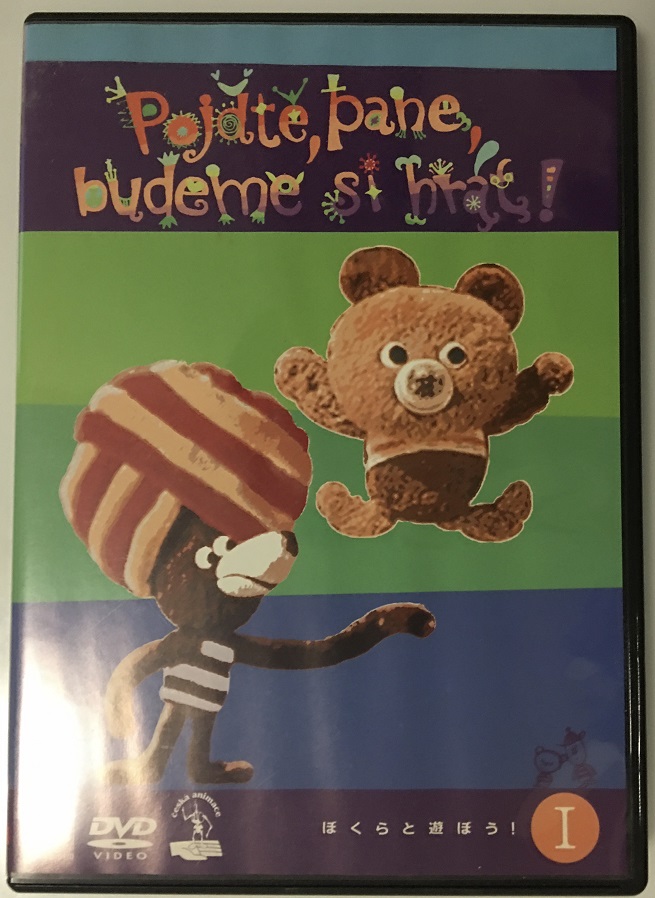
While most of the first Bears series (Hey Mister, Let’s Play!) is thankfully now available in HD versions from the Czech National Film Archive and has never looked better as far as home video/streaming releases go, the second Bears series (Who Threw That, Gentlemen?) has, to date, not received the same reasonable treatment. Mainly for archival purposes—and also to show just how the Bears have been (mis)treated over the years—I will take the opportunity to compare the three distinct sets of versions in which the second series has been presented since the dawn of the digital age, entry by entry, and how they stack up compared to each other. Moreover, I will take the opportunity to discuss the opening titles of the second series in general and how they more or less got worse over time, as well as how they are inconsistent between the three sets of versions.
The first set, of course, is the Czech DVD versions, initially released in Czechia in 2002 with the authorization of the original production studio Krátký Film Praha and reissued a number of times afterwards; each of the two DVDs consisted of one of the two Bears series. Until a few years ago, if you saw any of the Bears films online, they were almost always the same defective versions from these DVDs, with their edited-out credits, off-sync audio, and sourcing from faded prints with bits of footage missing; even to this day, in spite of the fact that the first Bears series now legally belongs to the NFA and the same is happening to the second series, these DVDs are still being sold in various online stores as the “official” versions of the Bears. (Here I must add that the NFA’s uploads of the first Bears series are not perfect, as they are taken from the archive’s own prints and not the original negatives of the films. Per an NFA representative whom Marin Pažanin spoke to, the reason for this is that, while the rights to all films produced under Communism are legally transferred to the NFA once over 50 years have passed since they were produced, Krátký Film Praha has consistently refused to obey the law and actually turn the original negatives of their films over to the NFA under these conditions. Hence, the negatives will probably continue to slowly rot in their archives for years to come, sadly…)
The second set, meanwhile, is the Česká televize versions. These are the versions that have been used by the Czech national broadcaster (its name in English simply translates to Czech Television) to air the Bears on TV since around the early 2000s, whether as standalone programs in themselves or as part of anthology series like Mistři českého animovaného filmu. Simply by virtue of actually preserving the original opening titles and keeping the audio and video more-or-less properly synced, they are already a huge step up from the Czech DVD versions, but as we shall see, the quality of the prints themselves can be pretty variable.
The third set, finally, is the Nippon Columbia versions, released on DVD in Japan in the early 2000s in the aftermath of a successful series of traveling Czech animation festivals in which the Bears, among other films, were screened for audiences all over Japan. (You can read more about the festivals here; the post includes links to archived versions of the festivals’ websites, too.) In terms of quality alone, these are by far the best versions of the second Bears series ever to be released anywhere, and may well have been derived from the original negatives in Krátký Film’s archives; however, they also have a number of idiosyncrasies that, as I will discuss below, shed a bit of extra light on the Bears’ production, as well as how these films are being (mis)treated by Krátký Film to this day.
Once again, I must thank Marin Pažanin for the very existence of this post. Aside from pointing me to the Nippon Columbia versions, he was also the first to notice many of the strange changes in the films’ very opening titles between different versions, and a substantial amount of this article is based on his observations. I should also add that, unfortunately, I do not own the Nippon Columbia versions of What Went Bang? and Dog Pieces, and can only rely on the highly compressed YouTube uploads of them as a metric of how they look color-wise; hence, a truly comprehensive comparison for those two entries is not possible at the moment.
What Went Bang? / Co to bouchlo? (1970)
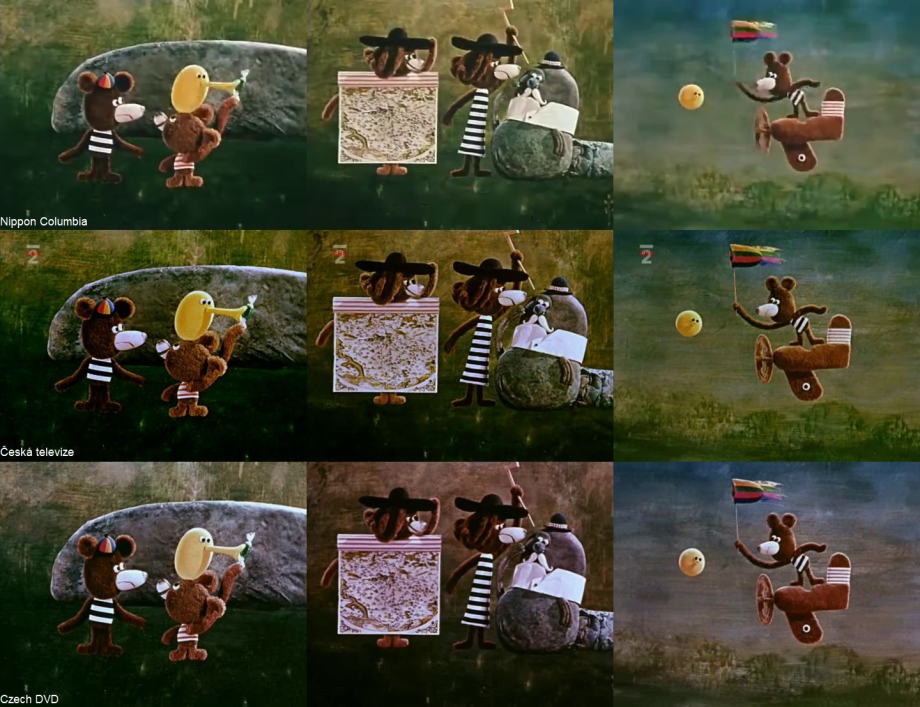
Based on the YouTube upload, the Nippon Columbia version definitely looks like the best transfer by far, with a pleasant range of vivid, natural colors. The Česká televize version is somewhat darker with a slight greenish tint, but it does have a similar range of colors overall, and whatever print it was sourced from could have been struck from the original negative. Both the NC and ČT versions have no noticeable print damage, and are much better than the Czech DVD version, which (especially in its second half) looks badly faded as if the film took place in a bleak, withering, war-devastated wasteland; the audio in the Czech DVD version is highly off-sync too, lagging behind the video.
The main difference between the NC and ČT versions is the opening titles: while the NC version retains the original Pojar-only directorial credit, the ČT version features the revised joint Pojar-Štěpánek directorial credit. As a matter of fact, the ČT version’s revised opening titles in general were clearly spliced in from a different print, as they are a little darker and more faded-looking than the rest of this version; the actual splice is remarkably well-done too, taking place right as the card is folded up at the end of the titles without accidentally removing any frames, such that there’s a pop in the audio but no actual skip in the music. Of course, the card with the joint directorial credit has a noticeably different backside, and it takes a single frame less to spin into view compared to the original Pojar-only credit.
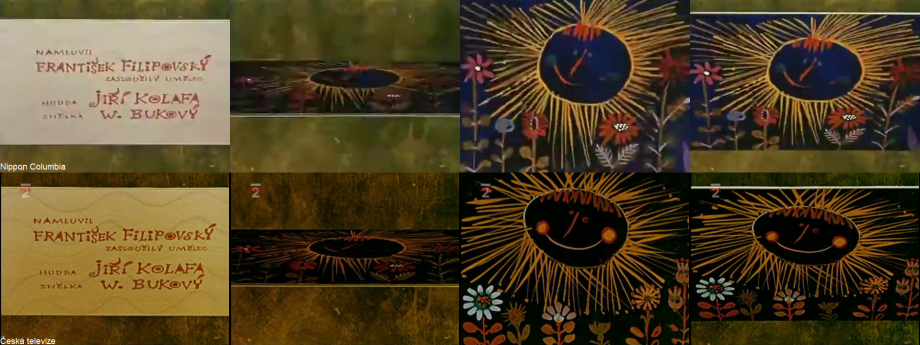
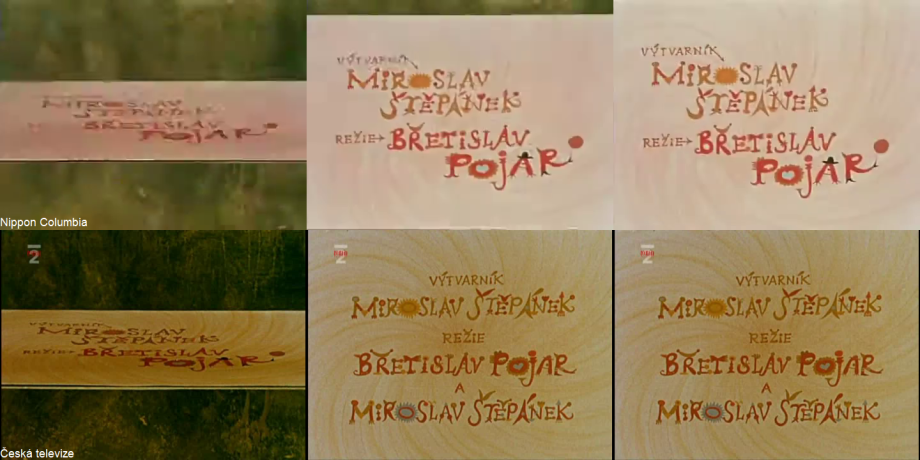
Consecutive frames in the Nippon Columbia and Česká televize versions of What Went Bang?.
Of course, if you take a close look at these frames, you’ll notice that the reason why the joint directorial credit’s flipping-into-view is shorter is even more strange: the flipping consists of a single frame of the original Pojar-only card—even though the joint directorial card’s different backside has already manifested itself! Truly bizarre refilming, to say the least—why couldn’t the folks who filmed the titles have just properly shot the joint credit spinning in? Why the shenanigans with the new card’s different backside already showing up, yet the original Pojar-only card being filmed again for just a frame before the actual joint directorial credit appears? Indeed, if you look at the background, you can see that, while those initial frames of the new backside and that single frame of the Pojar-only credit were shot against the same background used in the rest of the credits, the lighting in them is noticeably different from the original credits.
And for what it’s worth, the later frames of the joint directorial credit (and its new backside) spinning were shot against a completely different background altogether:
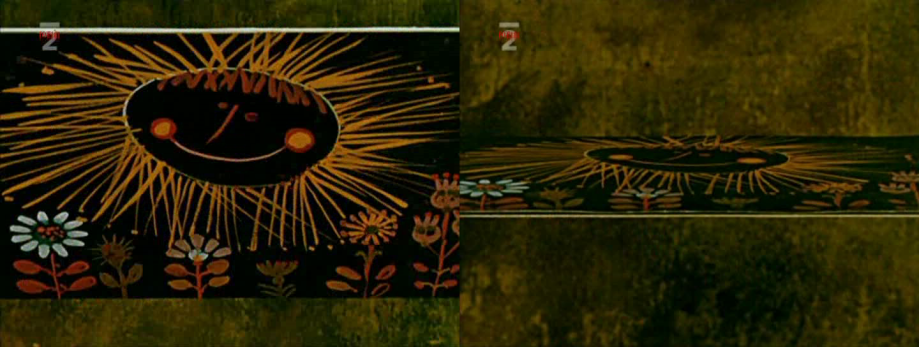
On the left is the new backside as seen when it first appears, on the right is the backside as seen later when the joint directorial credit starts to spin out.
What makes things especially bizarre is that this exact same apparent mistake with the original Pojar-only credit being filmed for a single frame in the reshot credits shows up in the other two co-directed entries. Could studio politics or even a grudge of some kind (the ongoing Pojar-Štěpánek dispute? the outside studio’s hatred of having to reshoot the credits?) have been involved in this strange shooting decision?
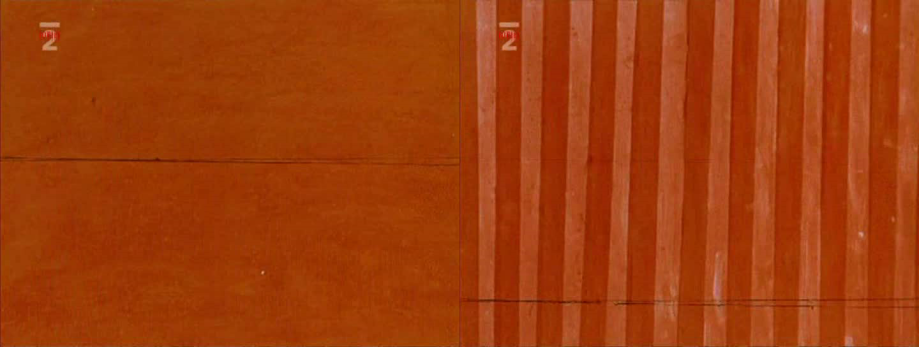
Consecutive frames in the Česká televize version of What Went Bang?, showing the splice between the revised opening titles from a different print and the film proper.
As for the opening titles of What Went Bang? in general: to begin with, there is a strange error when the “Central Film Distribution presents” title card starts to spin into the film’s title, in which, right after flipping around towards us the first time, for a very brief two frames the card starts to flip away in the reverse direction before moving back towards us. It seems as though, on its very first attempt, the outside studio responsible for filming the titles wasn’t quite sure how the card was supposed to flip:
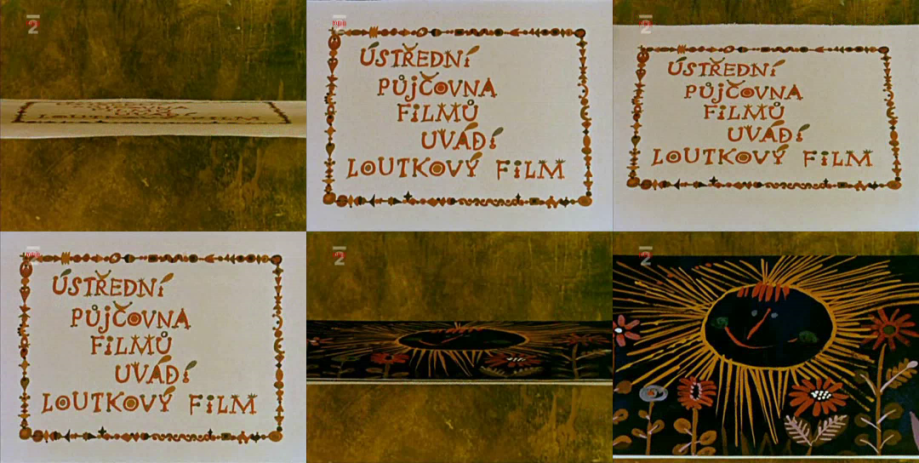
Consecutive frames in the opening titles of What Went Bang?.
Afterwards, it seems that the title cards’ backside was painted slightly off-center relative to the credits, such that, whenever the card spins from this point on (excepting the copyright card at the very end), at some point the card is shifted slightly to the right to give us a fuller view of the backside, in turn putting the brief glimpses of the preceding credits off-center. (The background, meanwhile, is shifted upward—or the camera itself is shifted downward.) This problem would mostly be fixed in the entries afterwards.
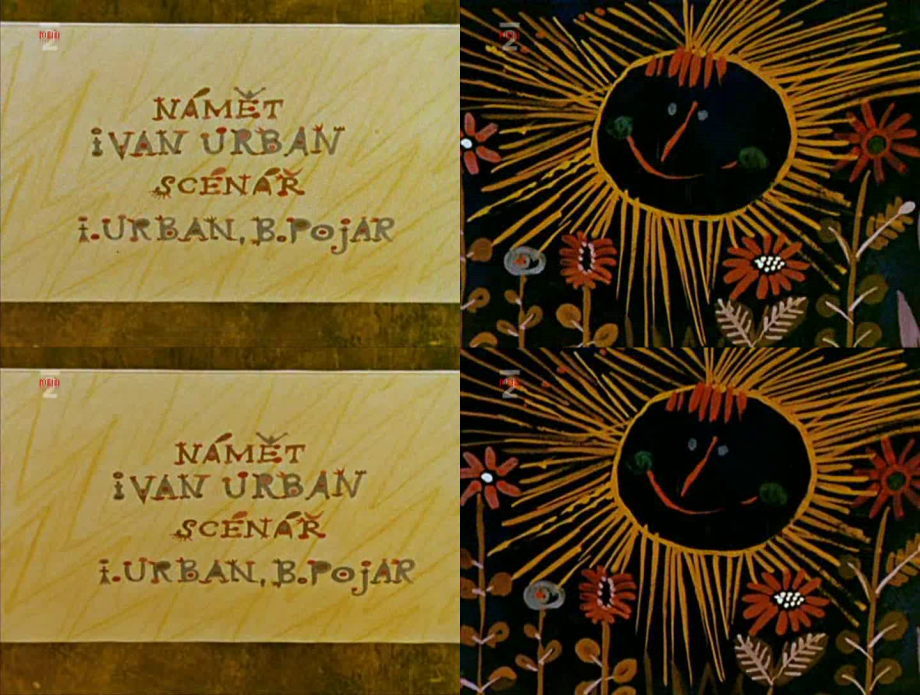
The writing credits and the backside spinning, before and after the camera shifts midway through.
Finally, this appears to be the only second-series entry in which the very last part of the titles, with the two rabbits pulling the folded title card apart, was actually filmed at Čiklovka as part of the opening scene proper: these rabbits are completely different from the ones that greet us at the very beginning of the film, and they, and the background, remain the same even after they tear the card apart to reveal the mailman rabbit.

As for how the credits were deleted from the Czech DVD version, which opens with the title card already in full view: the source print for this version has an obvious splice between the title card flipping and the very last flip cycle in the credits, with not even a glimpse of the film’s copyright card…
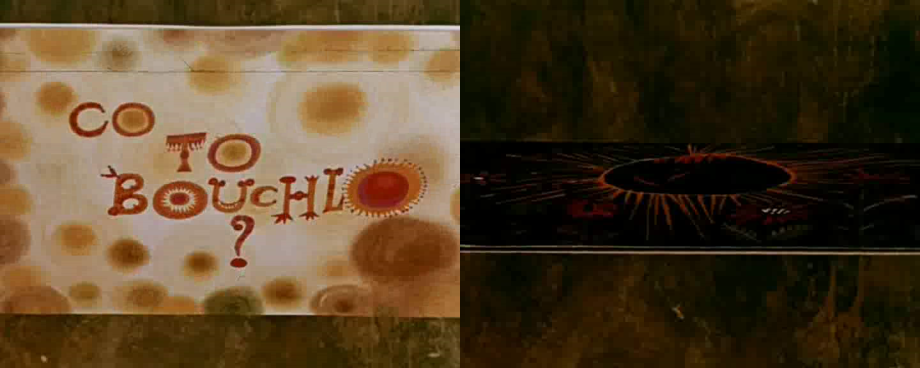
…not to mention a splice that completely cuts out the rabbits actually tearing the card in two. This happens in some of the other second-series entries as well, I have no idea why whoever cut these prints up felt the need to do this:
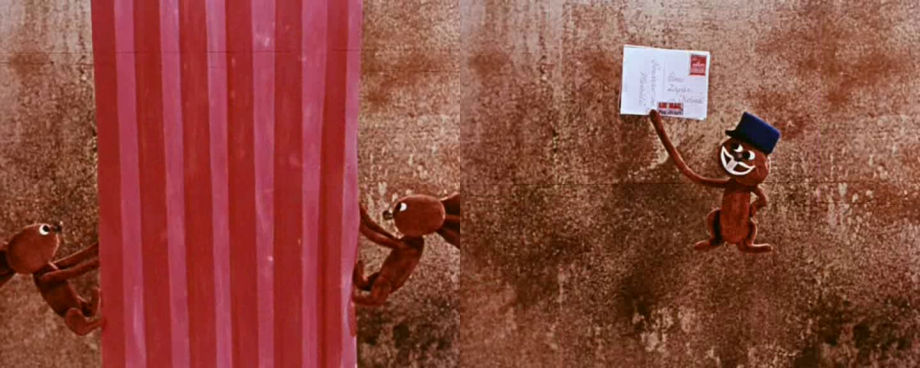
Onto the film itself: first off, in the montage of the Bears’ travel postcards, all of the shots of the postcards after the initial one of Little on a donkey are replaced with digitally frozen equivalents in the Czech DVD version. This removes a sort of “shimmering” effect seen on the postcard of the Bears against the night sky in both the Nippon Columbia and Česká televize versions, and for that matter, the postcard of Little with a banjo body on a canoe is onscreen for two frames less than it should be (as seen in the ČT and presumably NC versions). The really asinine part about the latter is that the audio track continues to play as if there were no missing frames here, causing it to lag further behind—were the folks responsible for the Czech DVD version deliberately trying to make the audio even more off-sync?

Later, the ČT version has a visible splice in the cut between Big and Josef at 4:48, but nothing appears to be missing between it and the NC version (except maybe a frame or two of Big looking on?); in both versions, the shot of Josef opens with the exact same frame of him turning around (and his posture here only shows up for this single frame), albeit the NC version does not seem to have any visible evidence of a splice like the ČT version does. The Czech DVD version, meanwhile, has an even worse splice at this same point, cutting out not only the aforementioned opening frame of Josef, but also a previous frame of Big looking on that was in the ČT version; the print gets really wobbly here, too:
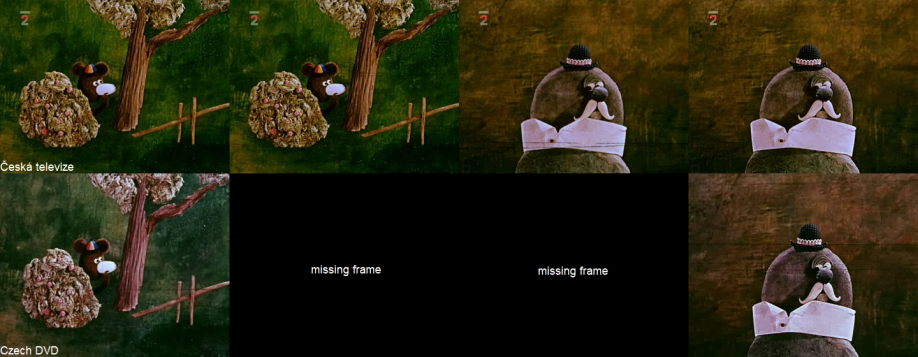
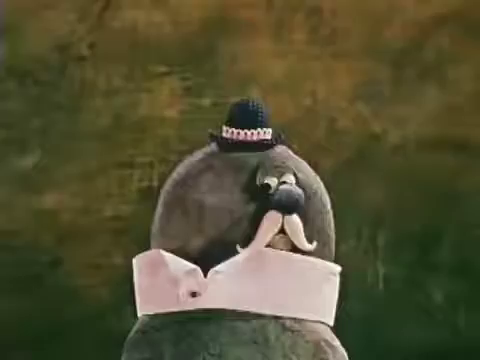
The first frame of Josef turning around as seen in the Nippon Columbia version. Note that there are no lines over the screen (indicating a splice) as there are in the Česká televize version.
Furthermore, around 6:33 in the ČT version when Big drives up to Josef as a truck, the Czech DVD version splices out not only the last frame of the background that the Bears had been on, but also two frames of Josef staring towards the incoming Bears:

Soon after, while Big is interrogating Josef around 7:07 in the ČT version, the Czech DVD version for some reason has trouble maintaining a consistent color scheme here, fluctuating in brightness and then turning even more brown and decrepit-looking; no such fluctuations occur in the NC and ČT versions:
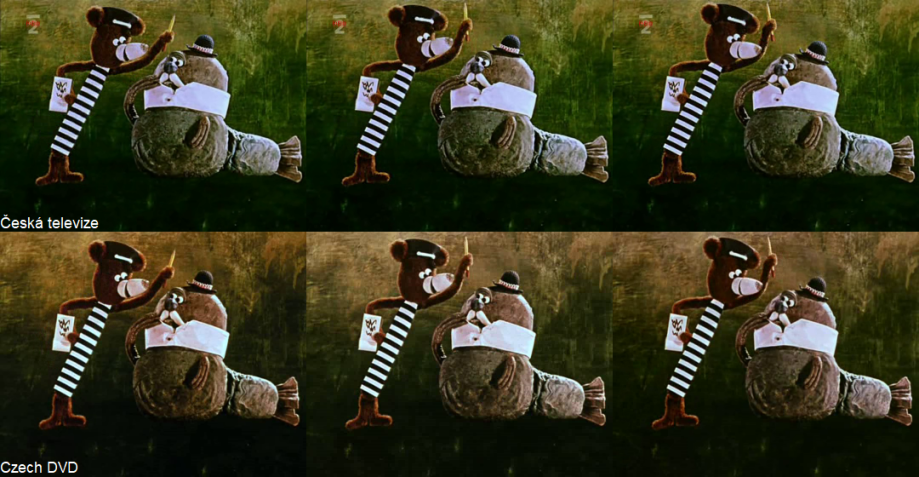
Finally, the end title card of the Czech DVD version fades in and out more slowly and smoothly than the ČT version; clearly these fades were digitally added for the DVD:
Dog Pieces / Psí kusy (1971)

Quite unlike What Went Bang?, the Česká televize print for Dog Pieces looks old, worn, and washed-out, but its range of colors is nevertheless quite varied and bright. The Nippon Columbia version as uploaded to YouTube, meanwhile, looks rather dark, though the colors are still quite vivid while being more natural-looking as well; neither of these two versions contain any noticeable print damage. It goes without saying that, again, the colors in the Czech DVD look pale, brown, and lifeless compared to the warmth of the NC and ČT versions, and the audio track lags slightly behind the video as well; for that matter, the Czech DVD print is also far more dusty and dirty than even the ČT version.
Perhaps befitting its status as the best entry in the second series, the titles in Dog Pieces are probably the closest that the second series’ titles got to being perfectly shot. There are no arbitrary background changes over the course of the titles, the card’s backside remains the same throughout (note that this entry uses a special red backside, in marked contrast with the blue backsides of all the other second-series entries), the rabbits who tear the card apart are now the same ones who greet us at the very beginning, and, even more interestingly than in What Went Bang?, the tearing leads seamlessly into the film’s opening scene.

That said, there are problems with the camera’s exposure noticeably getting brighter during some of the card’s spins. It’s especially ridiculous at the appearance of the film’s very title: just as the title card settles into place and we get a single frame where it looks bright, the exposure suddenly dims and the camera’s position even shifts to the left:

For that matter, in both the NC and ČT versions, there is a noticeable audio pop while the writing credits are on-screen, after which the theme music gets louder and clearer. Were there issues with the technology at the time the film’s soundtrack was being recorded, resulting in the first part of the theme being quieter and more muffled than it should have been?
As for the Czech DVD version, the title card settles down after spinning in the form of a digitally-frozen version. There’s actually an audible audio skip just before the card starts spinning again; obviously, no splice is visible, but clearly up to four frames were edited out from whatever print the soundtrack was taken from, as the film’s title is onscreen for four frames less compared to the ČT version. Then, to edit out the credits, there’s an obvious splice right when the title card starts spinning, skipping all the way to when the card stops spinning and is folded up, and then another huge splice takes place right when the card is about to be torn, cutting out not only the tearing-apart but also a whole second of the opening scene of the Bears rolling around on their hats!
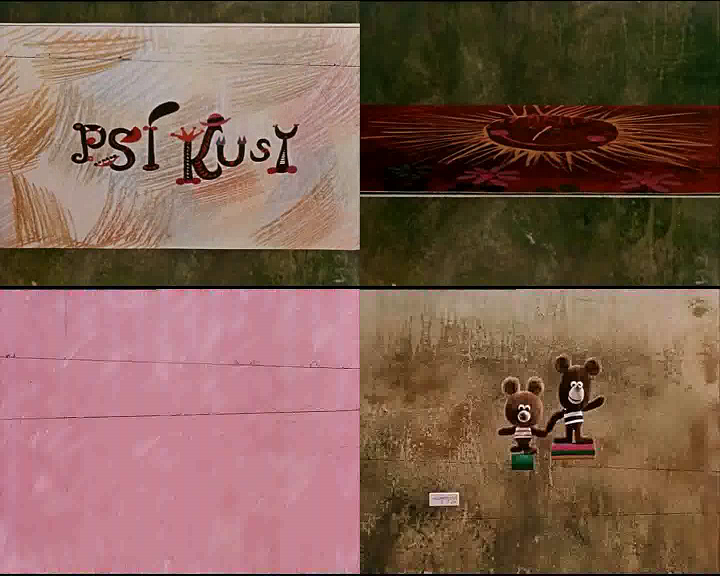
Onto the film itself, the first shot of the two Bears peeking at Dalibor from the tree, at 4:00 in the ČT version, is ruined in the Czech DVD version: the frames of Big actually saying “Look!” while pointing at Dalibor are missing, yet to compensate for this and keep time with the (already off-sync) soundtrack, the leftover animation of Big moving his hand out and the final pose of him pointing Dalibor out (with a slightly different snout position from the initial animation of him moving his hand out, since this is supposed to be after he’s already spoken) is significantly slowed down. See the comparison between the ČT (on the left) and Czech DVD (on the right) versions below; the audio track is from the ČT version:
Shortly afterwards, the shot of the Bears walking in and Dalibor messing with their cups, around 4:14 in the ČT version, is completely screwed up in the Czech DVD version, looking simultaneously slowed-down and horribly choppy (while the off-sync audio track continues running without interruptions, it seems). If all you saw of the film was the Czech DVD version (and this was, alas, the only way for most people to see the film for years), you’d think the animation was seriously messed-up here, but it’s very much the fault of whoever mastered this version for home video release; to try and explain precisely which frames were duplicated or missing (including, in the latter case, almost the entire animation of Dalibor digging around in Little’s cup!) would be far too complicated and confusing (believe me, I tried messing around with the Czech DVD and ČT versions of this scene in Shotcut to match them up and see precisely what went wrong with the DVD version and it nearly drove me nuts), so just have a video comparison between the ČT and Czech DVD versions of this scene, beginning from the same first frame:
And lest you are inclined to believe this is a problem specifically with the copy I have of the Czech DVD version, here are two other uploads of the Czech DVD version, showcasing the same digital mutilation of this scene.
Right after this, a single frame of Big marching behind the dog (around 4:21 in the ČT version) is missing in the Czech DVD version, causing his angry marching to look slightly faster than it should; no splice is visible here.
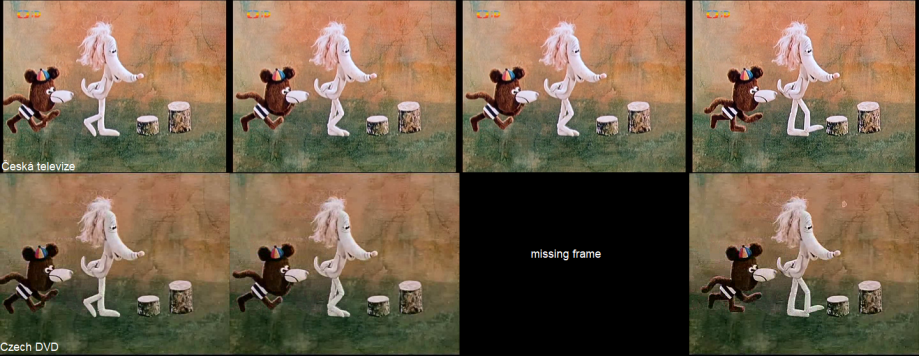
Later, in a third instance of egregious filmic destruction, the middle of the shot of the Bears talking and then chasing after Dalibor (around 4:55 in the ČT version) is also ruined in the Czech DVD version; it is missing some frames of Big blinking at Little, turning around, and looking on in Dalibor’s direction. Once again, in a half-baked attempt to compensate for this and keep time with the soundtrack, the animation of Little shaking his head no and replying “Not even ‘nyuh'” is slowed down, along with Big suddenly getting up as a cowboy centaur—in tandem with the Czech DVD version’s off-sync soundtrack, this completely ruins the element of surprise that makes the latter gag funny. See the comparison between the ČT and Czech DVD versions of this scene below (soundtrack from the ČT version):
Then, we have a fourth instance of filmic destruction: after Little puts away his Indian hat (6:42 in ČT version), we’re supposed to see him blinking rapidly and Big putting away his cowboy hat, followed by Dalibor placing his left hand on the strings and slowly raising his bow up. However, in the Czech DVD version, the animation of Little blinking and part of Big putting his hat away is significantly slowed down, and then the film suddenly cuts to where it’s supposed to be (relative to its off-sync soundtrack), in the middle of Dalibor bringing his bow up—effectively plastering over the remainder of Big putting his hat away and the first 15 frames of Dalibor preparing to perform! See the comparison below (note that ČT version gets really shaky in the cut between the two shots, even though no footage appears to be missing or spliced out; the very last frame of Big appears for just one frame in both NC and ČT versions):
Later, there’s yet another splice in the Czech DVD version as Dalibor gets flustered after the Bears pee (around 11:09 in ČT version). Three frames of Dalibor raising his head are missing:

Then, in a fifth instance of filmic desecration, the scene of Big figuring out Dalibor’s trickery (around 14:29 in the ČT version) is ruined in the Czech DVD version as well: the animation of Big raising his hand up and turning the violin knob is slowed down, but then the animation suddenly skips to him talking right as he puts his hand down and bobs forth (even though he isn’t even close to actually speaking on the soundtrack), with said talking animation and that of him angrily turning towards Dalibor also being slowed down to compensate for the deletion of his violin-listening while the soundtrack keeps running like nothing has happened! Once again, see the comparison between this wretched DVD version and the ČT version:
Afterwards, as Big is cartwheeling over to the saddened Little (15:13 in the ČT version), the Czech DVD has two frames with tape on them, indicative of a tear or similar repaired damage of some kind:
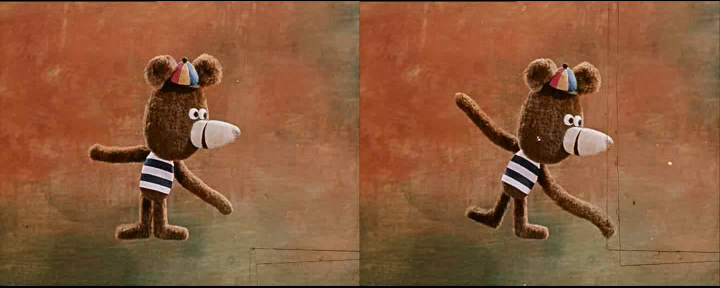
Some more taped damage then appears about two seconds later:

And, for a sixth instance of filmic desecration right before the end, Little jumping for joy at Big’s suggestion that they play themselves, and the beginning of their final performance, is also screwed-up in the Czech DVD version—as usual, the frames of Little actually falling to the ground are missing, along with two frames of the Bears crouching down and then two frames of Big-as-a-drum curving up after beating on himself, and a lot of the other frames are slowed down in a vain attempt to keep sync with the soundtrack. See the ČT-Czech DVD comparison here (audio from the ČT version):
To top this clinical analysis of the Czech DVD version off, the very last shot of the Bears performing is actually missing two frames towards the beginning (corresponding to around 15:40 in the ČT version), replacing them instead with duplicates of the surrounding frames:
And, to add insult to injury, a digital fade-out is added to the final shot in the Czech DVD version, causing it to fade out much earlier than in the ČT and Nippon Columbia versions. Digital fades in and out are also added to the “The End” card in the Czech DVD, looking slower than the original fades in the ČT version while occurring earlier.
Of the Panther Who Smelt Good / O pardálu který voněl (1971)

While the Nippon Columbia version is rather dark as presented on the DVD, it is by far the best version of the film out there, especially once it is brightened up in a digital editor (and it is from my revised, brightened-up version that the NC screenshots here will be taken). Some print defects aside (and they are especially worrying if this version was indeed sourced from the original negative), the colors are rich and varied, and of course the actual video quality is impeccable. The Česká televize version, meanwhile, is like Dog Pieces in that the print looks old and washed-out, even if the colors look bright; and the Czech DVD version, of course, looks faded and decaying as though the Bears’ forest was ravaged by a wildfire that somehow left quite a few trees intact, as well as being overly dusty.
Now here is where the second series’ opening titles start to get really messy. From this point on, it is not only the joint Pojar-Štěpánek directorial credit that was filmed at a later date and edited into the originally-shot credits, but several of the other credits had to be revised and refilmed and plastered over the already-shot titles as well, no doubt reflecting the rather chaotic situation at Čiklovka at this time with its abrupt changes in staff and organization.
The first few title cards, with the film’s title and the writing credits, have a similar problem as Dog Pieces: there are some issues with the brightness fluctuating dramatically as the cards spin. For that matter, the film’s title seems to have been painted off-center relative to its backside, such that, once the more properly-centered writing credits start to spin in, the backside is noticeably shifted to the left. See the consecutive frames below:
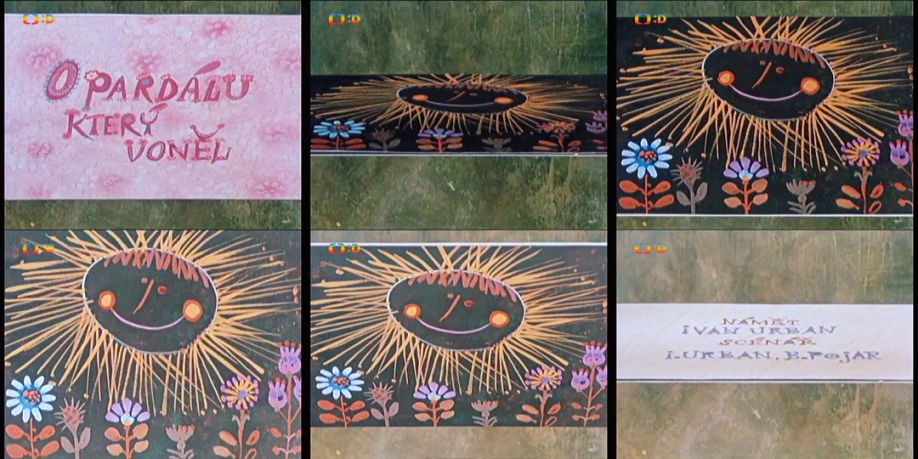
Then, the animator credits start to spin into view (again, the camera exposure gets much brighter than it should here), and at first it seems we’re getting the same animators as in the previous two entries: Boris Masník, Kristina Tichá, and Jaroslav Zahradník. But midway through the spin, the revised footage kicks in: all of a sudden, the background completely changes, and we end up with a rather different title card that credits only Masník and Tichá, acknowledging Zahradník’s departure from the series! (To their credit, the outside studio actually bothered to animate the new card spinning properly, such that the cut to the revised footage looks as seamless as possible, in spite of the background change.)
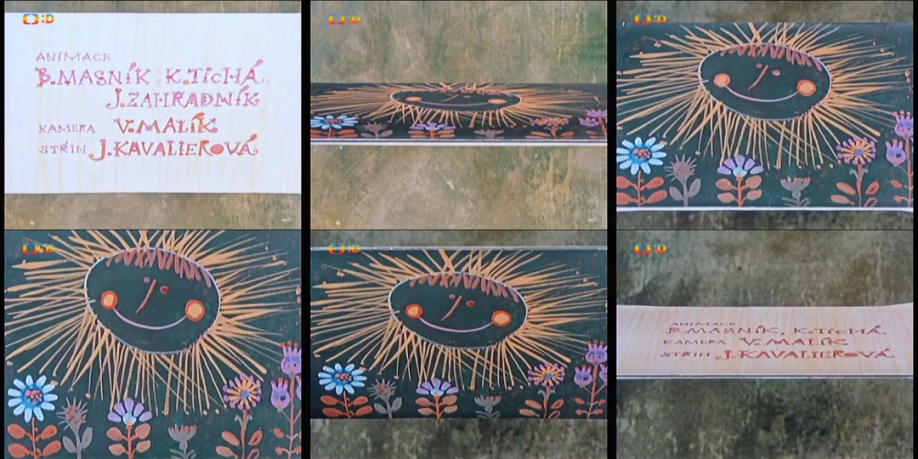
The revised title footage, with its different background, extends to the producer and assistance credits as well, perhaps because the originally-filmed titles credited the now-departed Zdeněk Bumba as producer. Note that a new defect is introduced into the second series’ credits from this point on: then-technical assistant Ivan Vít is now credited as “J. Vít” rather than “I. Vít” as he should be!
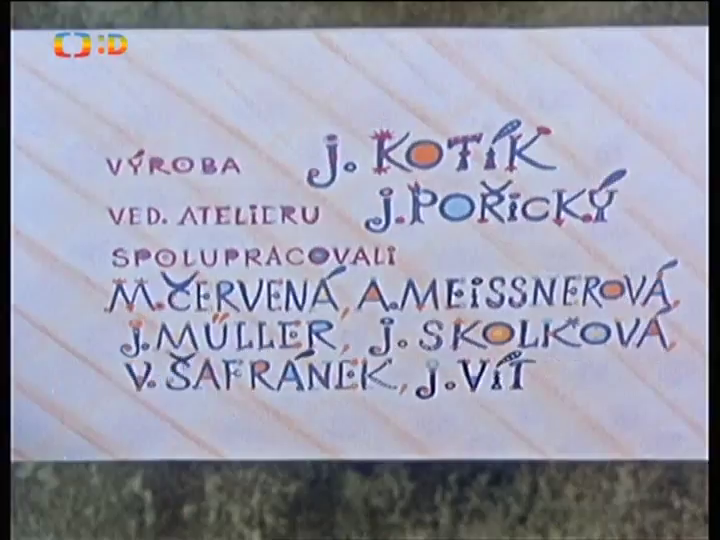
As the voice and music credits spin into view, the background changes yet again, and not to the one seen behind the first few titles either. Perhaps the special presence of Naďa Urbánková required this title card to be refilmed after the fact as well, with the original version crediting only František Filipovský as usual?
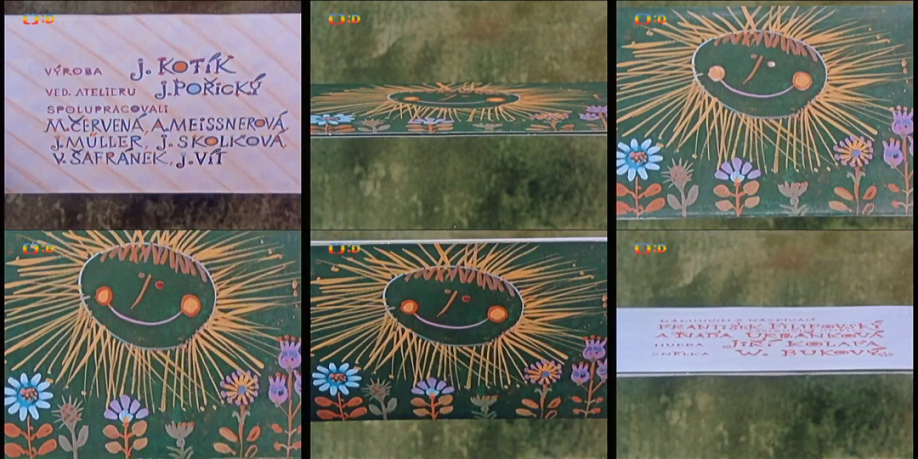
And finally, of course, we have the joint directorial credit—which, unlike for the other two co-directed entries, actually shows up even in the Nippon Columbia version! (Perhaps, in this case, the title revisions were made even to the original negative?) Note that the outside studio responsible for the titles actually cared enough to give it the same backside as the rest of the titles for once; of course, it must be observed that the background once again abruptly switches here, and notice how the backside looks darker, too. For that matter, there remains the insistently strange way in which the joint directorial credit flips into view, with a single rogue frame featuring the Pojar-only directorial credit; it is all the more bizarre considering how the other seemingly last-minute revisions to the credits here were at least done in a semi-professional manner (e.g. the joint credit’s backside actually being consistent with the rest of the titles).
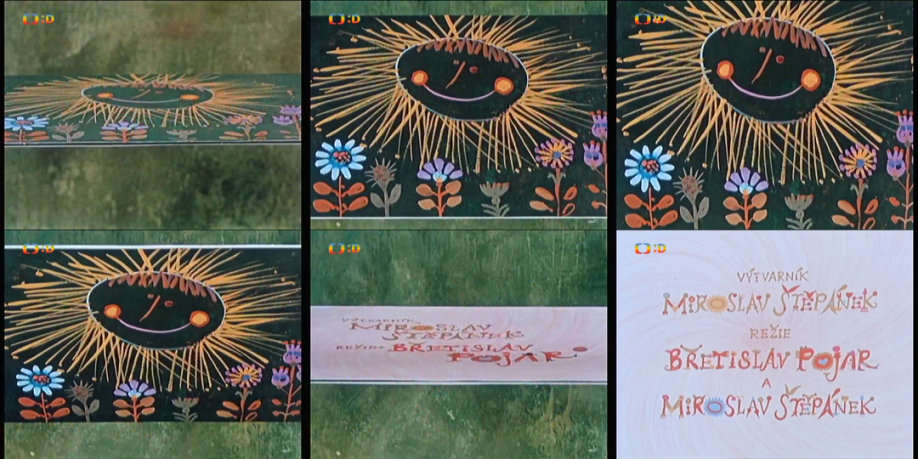
Again, did Pojar or someone else require that a single frame of the original Pojar-only card be present, as some kind of insider reminder that Štěpánek’s co-direction credit was filmed after the fact, or did the folks to which the credits were farmed out really hate the job this much? Really, it makes no sense…
Anyhow, the joint directorial card spins out against yet another changed background from how the Pojar-only credit spun in. Interestingly, the background remains the same as the Krátký Film copyright card comes in, no longer bearing a credit for Bratři v triku as it did in the previous two entries; perhaps, as originally filmed, the copyright card did credit that studio, with the joint directorial credit and the revised copyright card being conveniently reshot together later on?
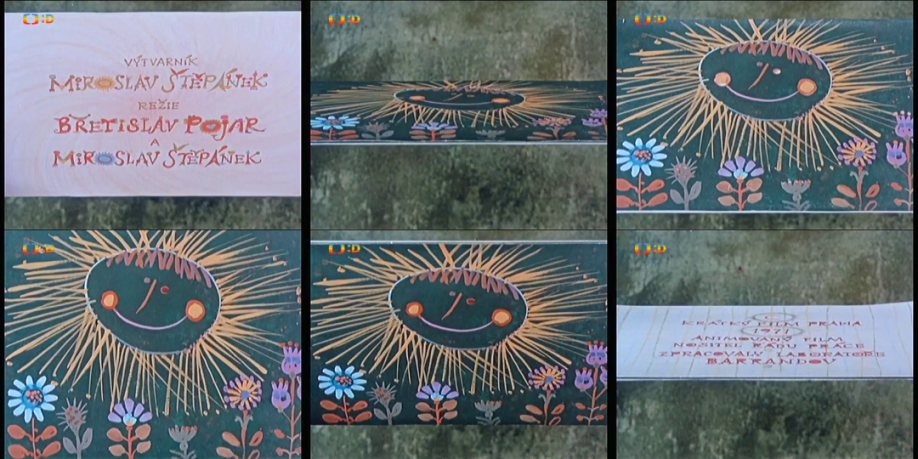
And finally, from this entry on, even the transitions between the titles and the films’ opening scenes start to get really slapdash. Here, midway through the card being torn in half, the film cuts to a slightly different card being torn in half to lead into the Bears racing, and the background behind the card completely changes too:
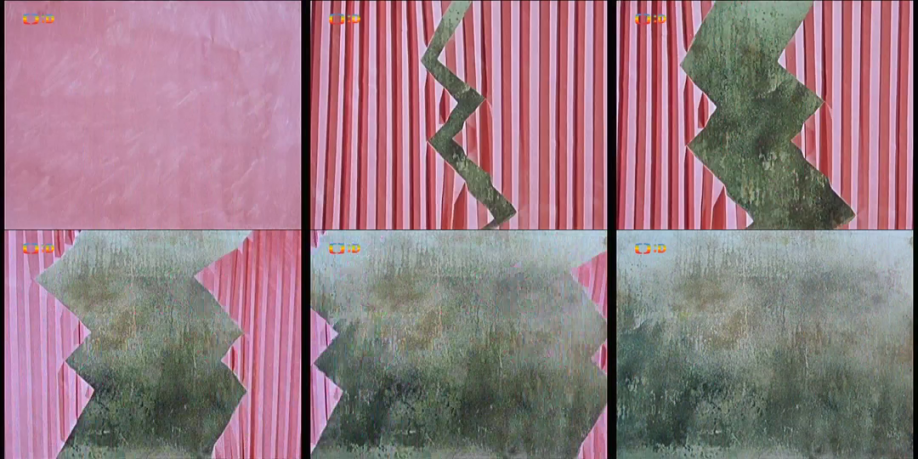
Moving onto the differences between the three prints: to begin with, there’s some film damage on the title card for a single frame in the ČT and NC versions (around 0:12 in my revised version of the NC transfer). This is not present in the Czech DVD version.
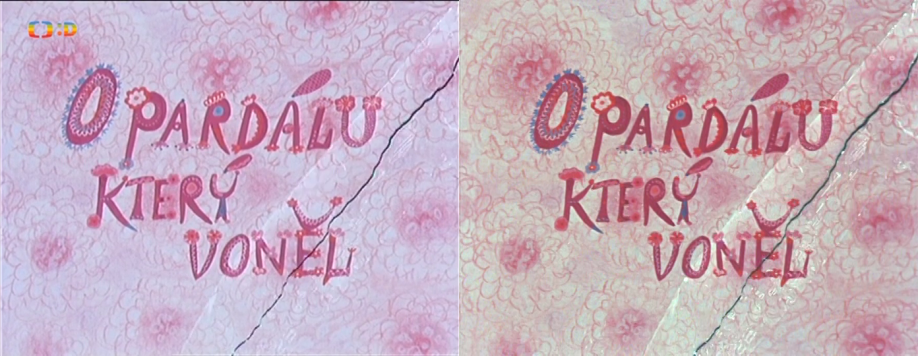
As for how the credits were edited out in the Czech DVD version: there’s an obvious splice as the title card starts spinning, skipping to when the final card ends its spinning and is folded up, and then another splice takes place before the rabbits can tear the title card in half, cutting out not only the tearing but also over half a second of the opening shot!
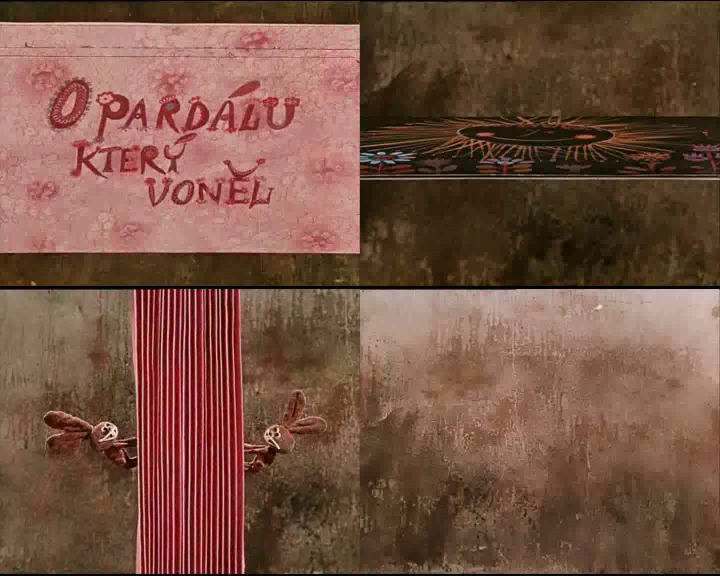
Onto the film itself, the shot towards the beginning of the Bears racing down the screen (from 0:50 to 0:53 in the revised NC version) is seriously messed up in the Czech DVD version. Some 11 frames of the Bears turning to the left towards the beginning are missing—but to compensate for this and keep time with the (already off-sync) soundtrack, all of the other animation in this scene is slowed down slightly, resulting in a distinct ghosting effect in the visuals. See the comparison between the ČT and Czech DVD versions below (the soundtrack is from the ČT version):
Later, the shot of Little getting enthusiastic about the Panther (3:25 to 3:38 in the revised NC version) is even more screwed up in the same way. Again, in the Czech DVD version, 6 frames of animation are missing between Little landing on the ground and him trying to run over to the Panther, and afterwards at least 8 frames of Little talking to Big are missing as well. Once again, they tried to compensate for this by slowing the rest of the shot down; see the comparison between the ČT and Czech DVD versions below:
Immediately afterwards, in both the ČT and NC versions, there’s an intriguing shooting error in which weird objects and blurred hands(?) are present in the very first frame of the Panther walking along (3:38 in the revised NC version). This frame is absent in the Czech DVD version, which replaces it with a repeat of the frame afterwards—deleting the first frame of the Panther’s walking animation in the process.
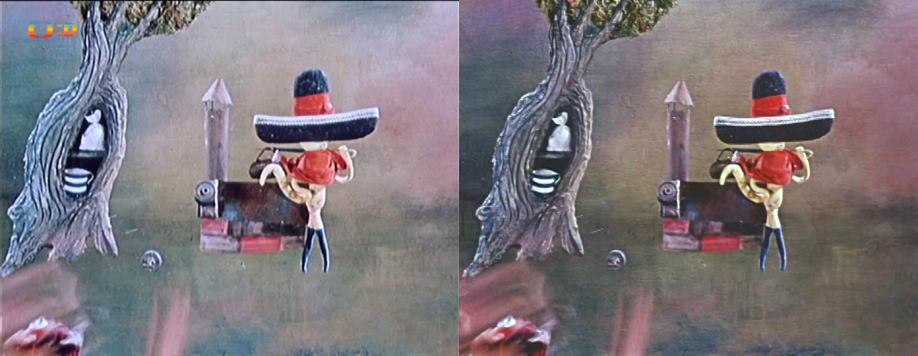
Then, both the ČT and NC versions are actually missing at least a few frames of the cut between the Panther and Big looking on, around 4:37 in the revised NC version; the ČT version, in fact, is missing even more than the NC version, with very obvious print damage such that the transfer shakes violently here. To be specific, compared to the Czech DVD version, the ČT version is missing five frames, one of Panther laying there and four of Big staring and moving back:

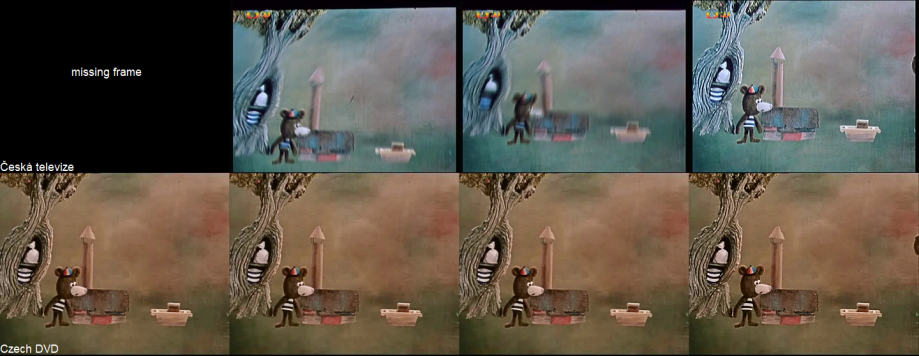
Later, in the both the ČT and NC versions, there’s some horrific print damage for three frames as Little reaches out for the Panther (6:44 in the revised NC version); the ČT version also gets very jittery in the cut to Big afterwards, though no frames are missing compared to the NC version. This damage is not present in the Czech DVD version, which in any case replaces the last two frames corresponding to the damage with duplications of the frame just before them—thereby freezing Little from reaching out to the Panther as far as he did in the ČT and NC versions:
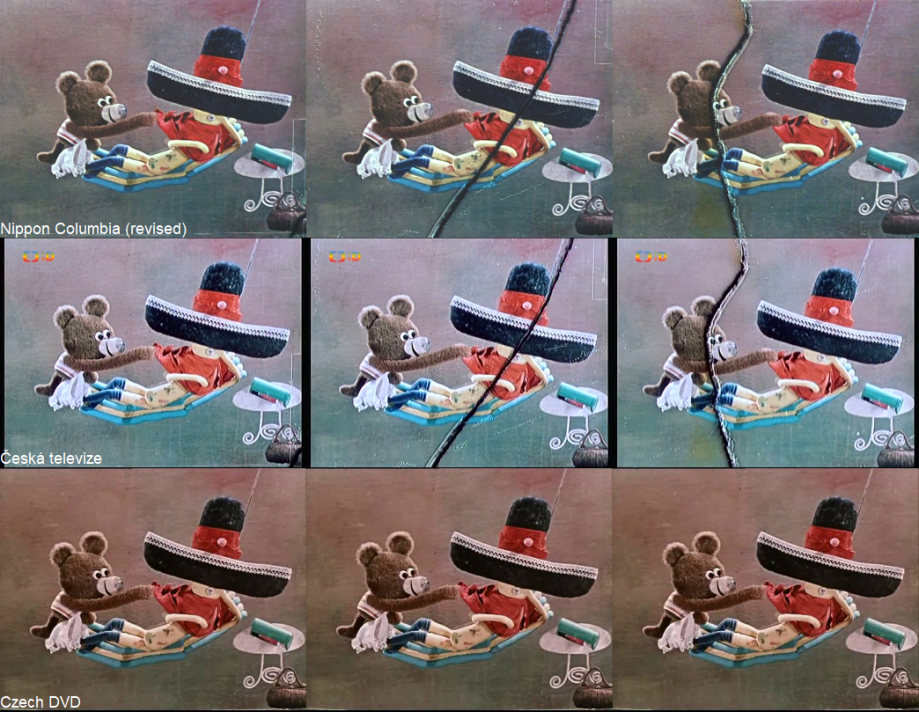
Further on, in the cut between shots at 9:24 (revised NC timestamp), a splice is visible in the NC version, but no frames are missing between it and the ČT version; on the other hand, the Czech DVD version is missing a frame of the Bears looking at the Panther compared to the ČT version, and the print gets noticeably shaky there, too:
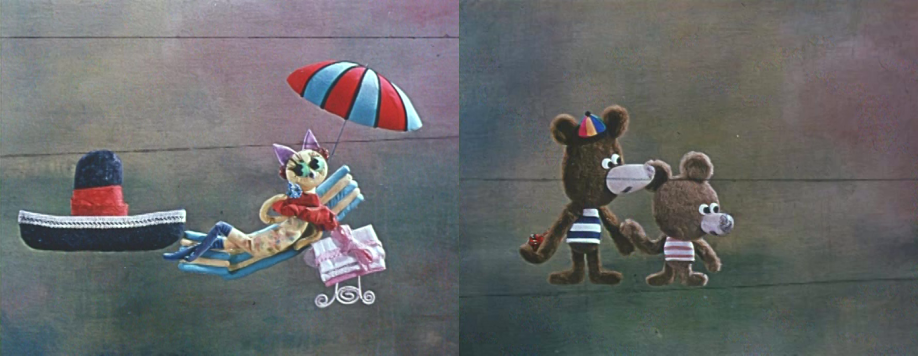
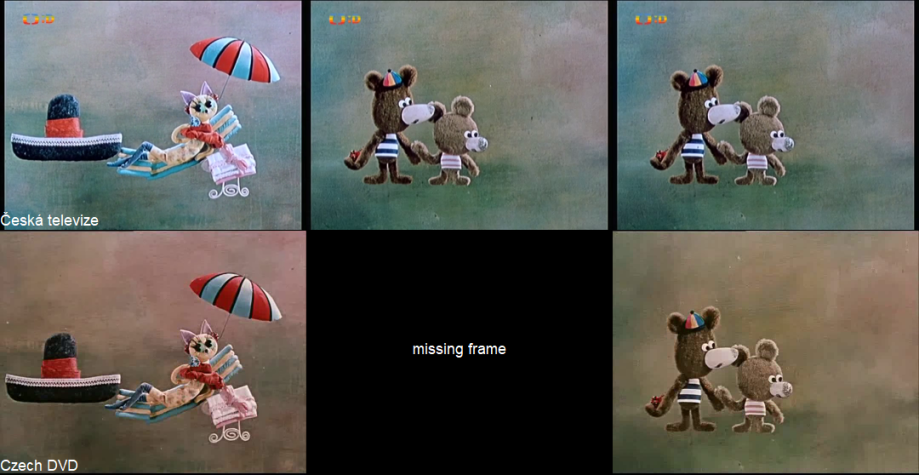
Right after that, there’s a strange issue with the ČT print taking on a blue tint for several frames (corresponding to 9:27 in the revised NC version). This is not in the NC or Czech DVD versions:
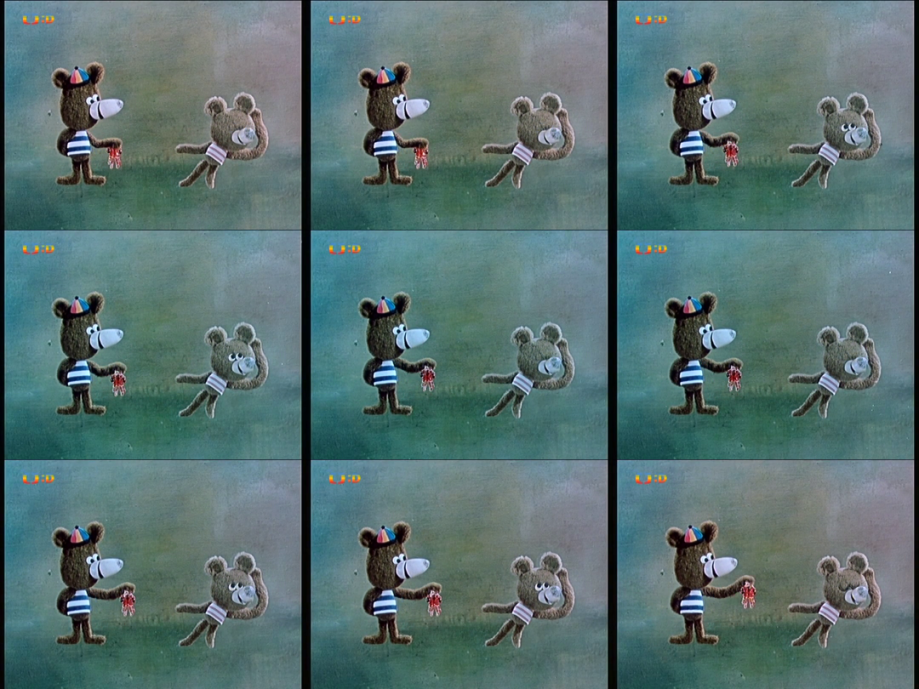
Much later, there’s a splice in the Czech DVD version that removes four frames as the Panther begins talking to Little (corresponding to 15:08-15:09 in the revised NC). It also ruins the audio of her asking him “Co tu děláš?” (“What are you doing here?”) by splicing out the “š”.
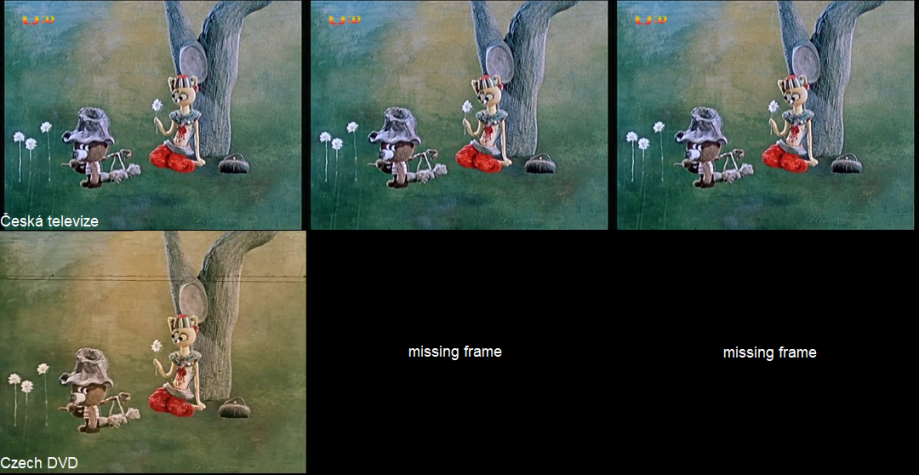
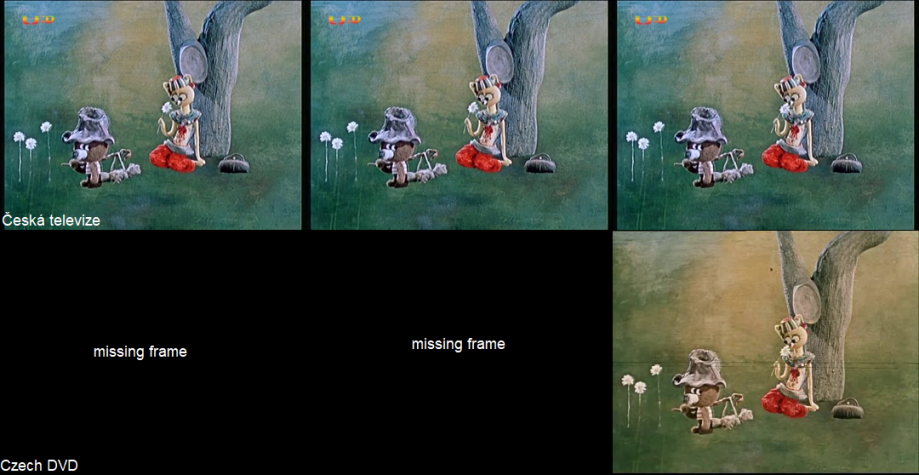
Finally, the very last scene fades out earlier in the Czech DVD version than in the NC and ČT versions; based on how the dust on the print fades out with the film itself, this was clearly a digitally-added fade. For that matter, the “The End” card’s fades in and out are slower, more gradual, and digital in the Czech DVD version as well. Interestingly, the fade-out of the end card occurs earlier in the NC version than in the ČT version (ČT on left, revised NC sped up to 25 fps in middle, and Czech DVD on right; soundtrack is from the ČT version):
And Don’t Call Me Vašík / A neříkej mi Vašíku (1972)
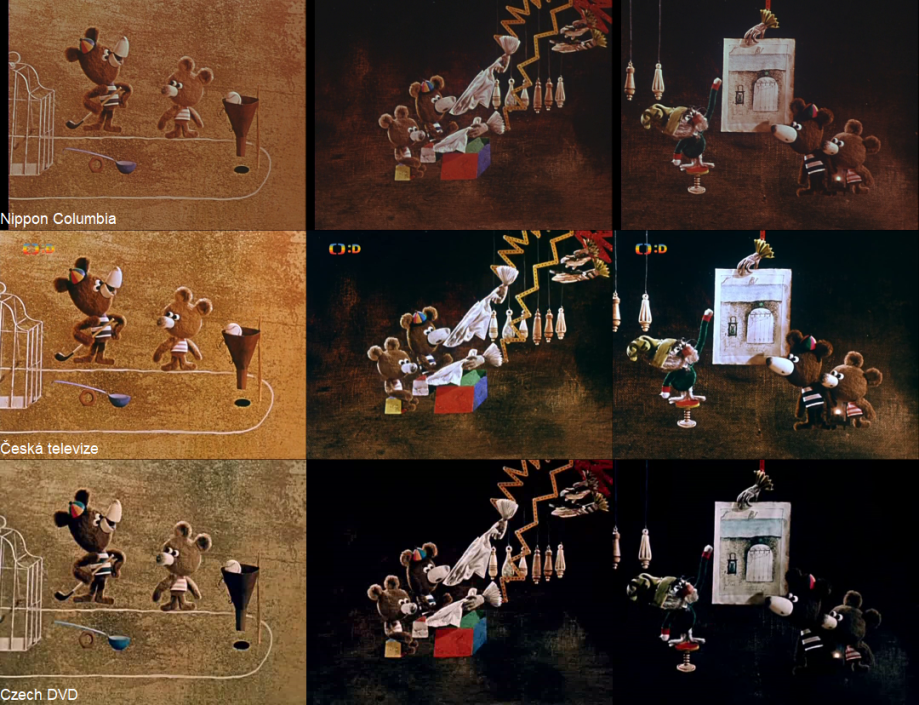
Now we have another case in which, similar to What Went Bang?, the Nippon Columbia and Česká televize versions—both with the same fairly rich and vivid color scheme—are remarkably similar to each other. Of course, the opening titles on the ČT version feature the revised directorial credit—again, as with What Went Bang?, the NC version features the original Pojar-only credit, and the titles on the ČT version were clearly spliced in from a different print—and in comparing the two versions side-by-side, the colors in the ČT version do have a more pronounced contrast than in the NC version; at any rate, though, the print from which the body of the ČT print was sourced does not seem too far removed from the original negative. Aside from the opening titles, the main difference between the NC and ČT versions is that the NC transfer is rather dark, though this can easily be remedied by simply tinkering with its brightness in a digital editor. In short, as far as the transfers themselves go, the ČT version is the best one color-wise, though the NC version obviously cannot be beat in its clarity. (And the Czech DVD version…really, how often does it need to be said that it’s much deader-looking color-wise than the other two versions, to say nothing of how wobbly and dusty it is?)
Of course, it’s hard for me to ignore the coincidence that the two co-directed entries which are presented with the Pojar-only directorial credit on the Nippon Columbia DVDs—What Went Bang? and And Don’t Call Me Vašík—happen to be the very same entries in which the ČT versions were taken from better prints (remarkably close to the NC versions at that) than for the other second-series entries, even as the ČT versions spliced in the revised opening titles from different prints. How could this be? Maybe the original ČT prints for these two entries really were so deteriorated in some way that they had to replace them with better-looking prints, even as the other three second-series entries would continue to be aired on TV in washed-out, ancient-looking prints. A more intriguing possibility, however, could be that the original ČT prints also only credited Pojar as director, and with the litigation that Štěpánek pursued in later years to ensure he would co-credited with Pojar as director on future airings and releases of the co-credited entries, those prints were no longer usable; hence, it would have been necessary for Česká televize to obtain prints that actually had the joint directorial credit, and perhaps in the process of replacing the prints, they decided to take the opportunity to actually seek out good prints for the bodies of these two entries anyhow, while splicing in the revised opening titles from elsewhere. Very much conjecture, I know, but it’s something I can’t help wondering about…
Onto the titles themselves, it is here that the cards’ spinning in general starts to become much more abrupt and hasty-looking than usual. It is only at the start of the film’s title spinning into the writing credits that we get a frame of the title card starting to spin; for all the other credit transitions, the spin commences with the onscreen credits cutting right to when the backside is already starting to spin towards us.

For that matter, issues with the fluctuating brightness of the camera exposure are even more prominent here than in the previous entries’ titles. The writing credits become much brighter for the last four frames they are onscreen, and this increased brightness lasts until the last two frames of the animation-camera-editing credits, in which the exposure dims again. (Note how abruptly the card begins to spin out in both cases, as mentioned above.)
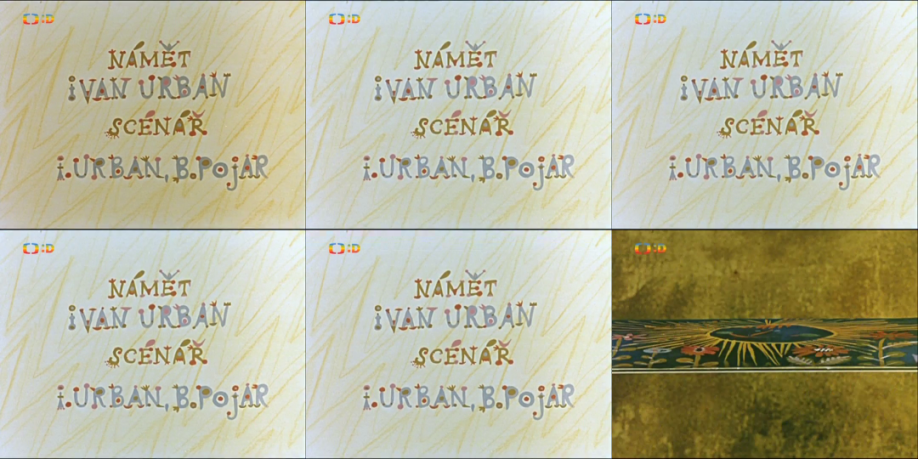
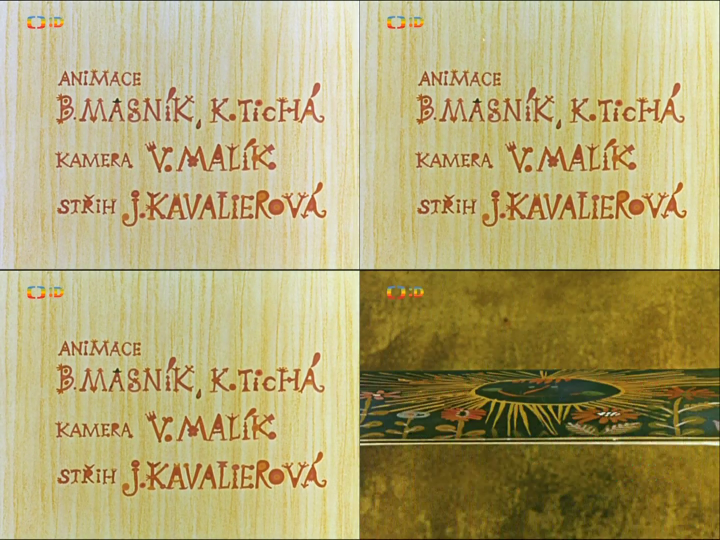
Then, as the voice and music credits start to spin in from the producer and assistance credits, not only does the exposure get brighter again, but even the background changes:
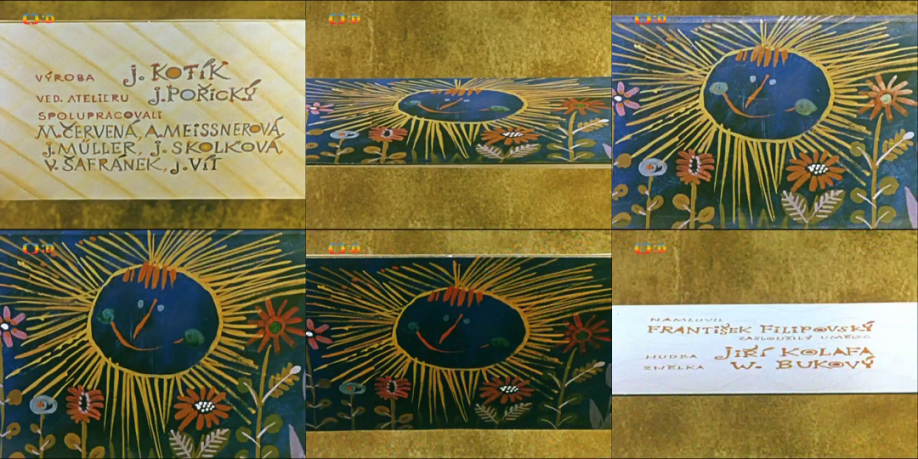
And finally, this brings us to the artist-director credits. In the Nippon Columbia version, we can see that the original Pojar-only directorial credit spins into view with the same background as the voice and music credits; by the time it starts spinning out into the copyright card, however, the background has reverted to the one seen earlier in the titles:
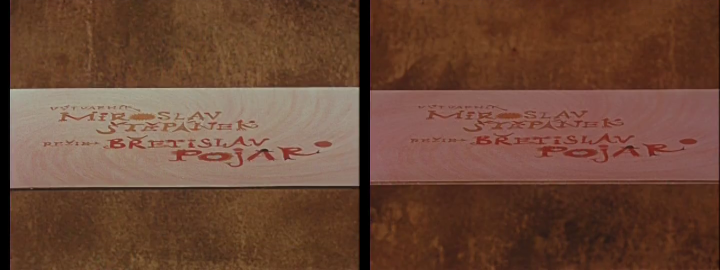
Suffice to say, things are even messier in the ČT version. As in What Went Bang?, the backside of the revised artist-director credits is completely different, and as always, the original Pojar-only credit is inexplicably filmed for a single frame before the joint Pojar-Štěpánek credit suddenly cuts into view; and this time, the background against which these initial frames were filmed is completely different from the rest of the titles:
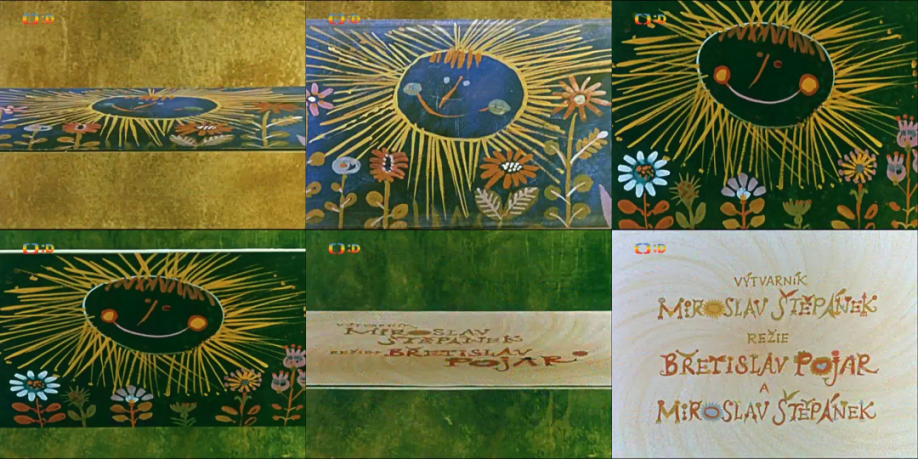
Later, the revised credits are at least shot spinning out against the same background as the copyright card, but the lighting is completely different and green-tinted, and the different backside ends up cutting to the original one as the copyright card spins in anyhow:
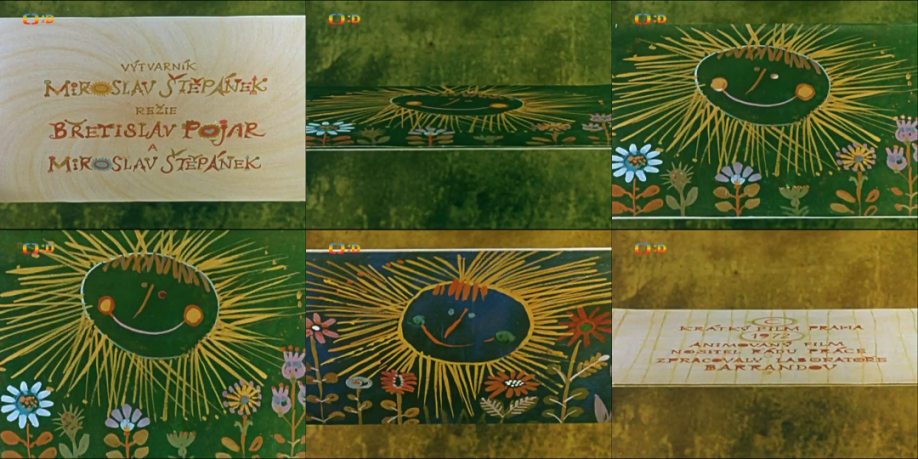
As for the copyright card, the lighting on it gets visibly brighter in its last three frames onscreen, and then gets darker in the midst of its spinning out:
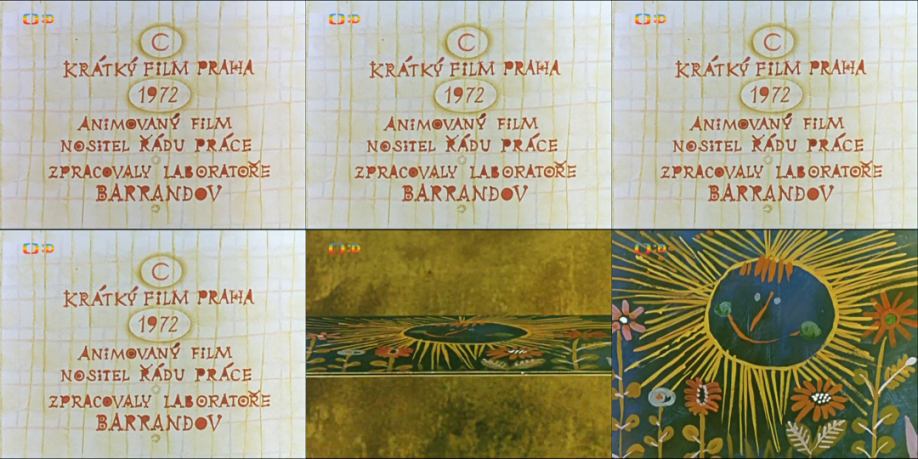

And for what it’s worth, here is the visible splice in the ČT version indicating that its titles were taken from a different print. As in What Went Bang?, it was done professionally enough that there are no missing frames or skips in the audio:
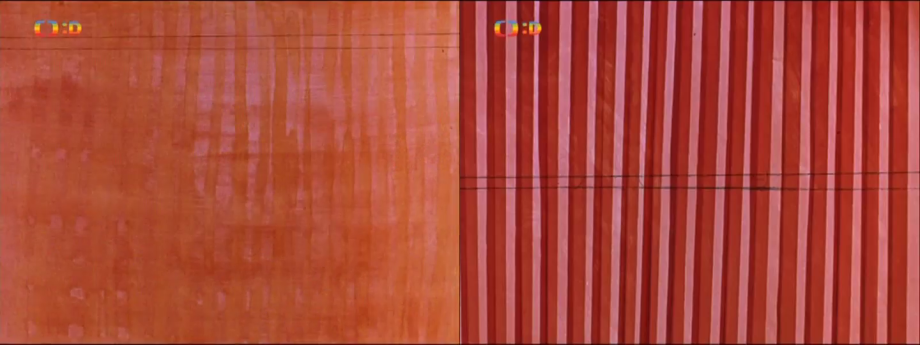
And finally, the transition between the titles and the opening scene here is even sloppier than in Panther. The rabbits tear the card open only to reveal the same background on which they already were to begin with—and then the film just cuts to the background of the opening scene:
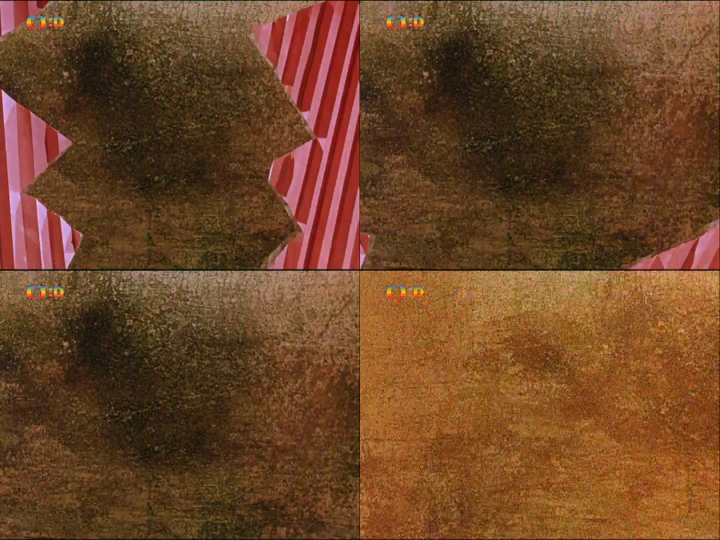
As for how the credits were deleted in the Czech DVD version: the splice to the very end of the titles occurs shortly after the title card starts spinning, in this case making it look as though the animation of the backside flipping towards us is being repeated before it has even finished:
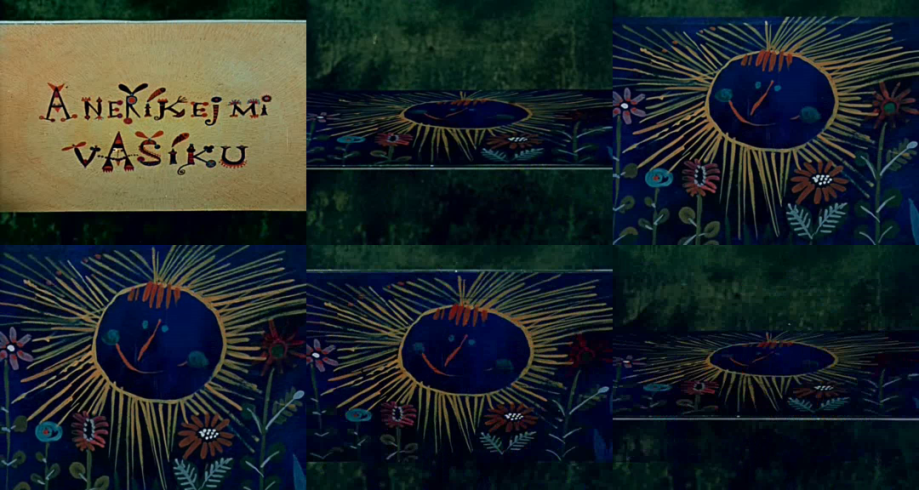
This time, at least, the rabbits actually tearing the card apart is not spliced out; however, the very last frame of the titles showing a clean view of the background behind them is, along with a whopping 22 frames afterwards (almost a full second!) of the opening scene’s background!
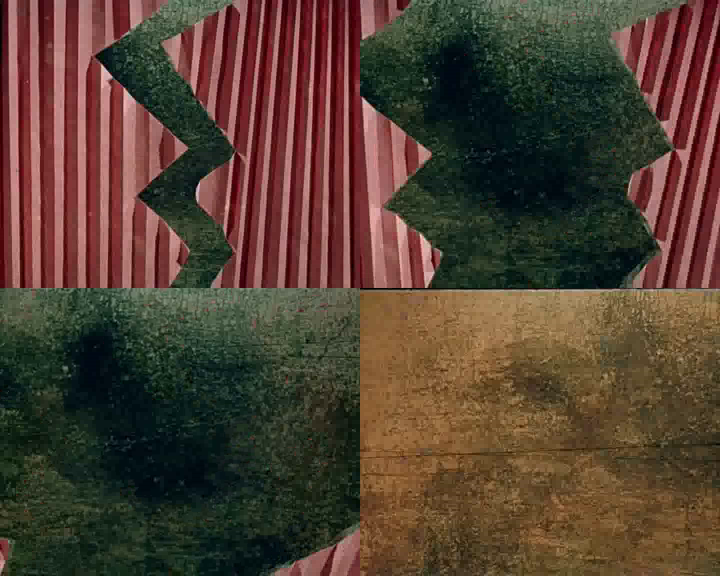
Onto the film proper: to begin with, the Czech DVD version is missing four frames of the golf club bag getting kicked away by Little, around 1:18 in the ČT version, and the print noticeably gets shaky, too:

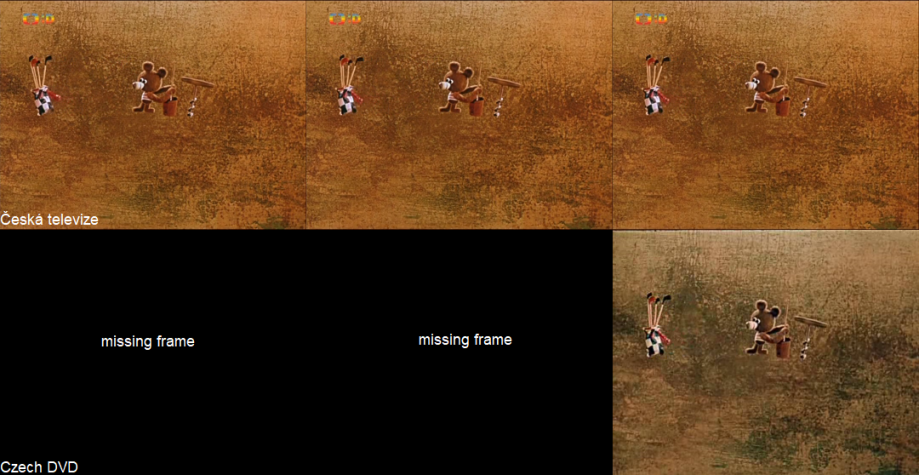
Later, towards the beginning of the shot at 1:59 (in the ČT version) of Vašík’s hiding place, the Nippon Columbia version appears to be missing about five frames of the initial view of the area compared to the ČT version. Of course, close frame-by-frame inspection indicates that the ČT version seems to actually freeze up for some reason here, which would indicate artificial prolonging of some kind, though there is no glitch in the audio (though, given the repetitive sound effect emanating from Vašík’s lair at this time, it’d probably be easy to artificially extend the audio as well). At the same time, though, the NC version does noticeably get a little shakier around this point, though no splice is visible; in any case, none of the actual animation of Vašík’s periscope emerging is missing. As for the Czech DVD version, it does contain one more frame of the still shot compared to the NC version, but in total is also missing five frames compared to the ČT version—including, in this case, the first frame of Vašík’s periscope!
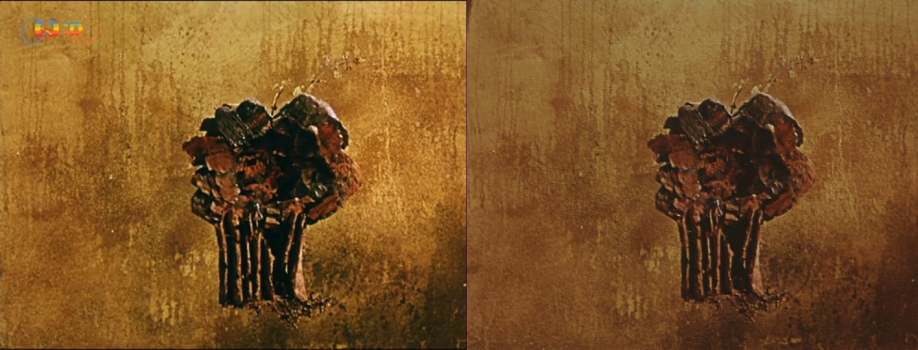
The first frame of Vašík’s periscope emerging, as seen in the ČT and NC versions—and not in the Czech DVD version.
Then, in the cut between the water spewing from the hole and Little running over to Vašík’s hiding spot around 2:33 in the ČT version, the ČT version is missing the very last frame of the water spewing out, which is intact in both the NC and Czech DVD versions. But then the Czech DVD version immediately follows this up with a splice that cuts out three frames of the next shot with Vašík compared to the ČT version! (I think the NC version is missing a frame here as well, though I’m not certain—it really isn’t easy to compare the NC versions to the ČT versions, due to the NC versions utilizing the NTSC video format which essentially duplicates frames to convert a 24-frames-per-second film into 29.97 fps, making a proper frame-by-frame comparison with the 25-fps ČT versions very difficult.)
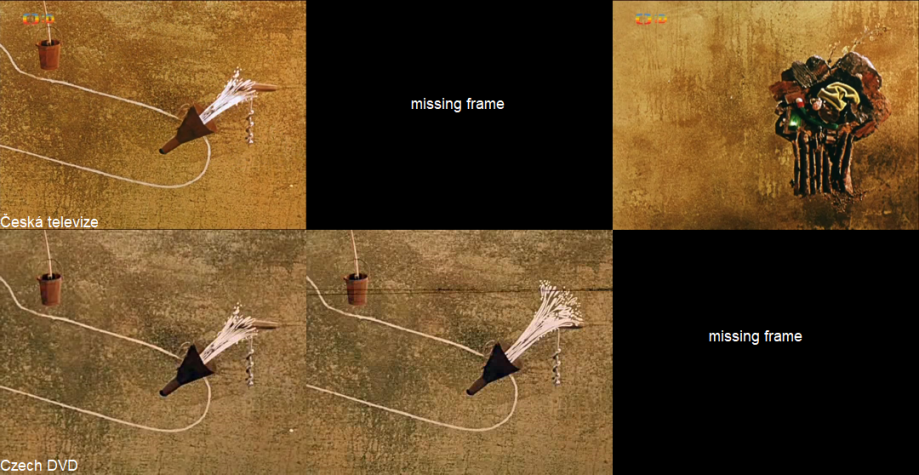
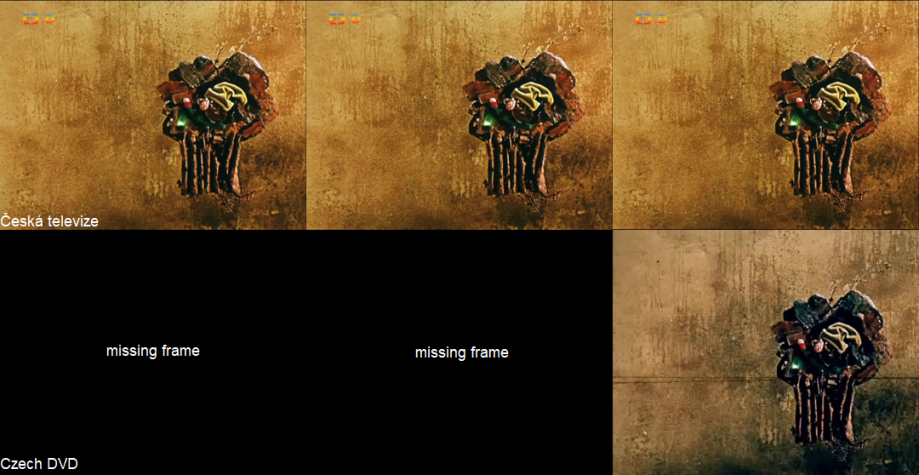
Later, when Little is crying foul against Big and demanding he try a harder golf course, there are two frames in the Czech DVD version with some nasty-looking purple film damage, corresponding to 3:15 and 3:16 in the ČT version—are these literal cigarette burns or something!?
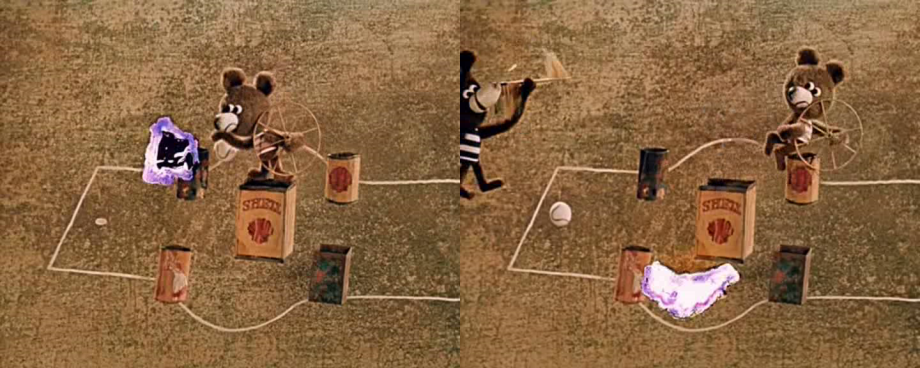
And then, at 5:49-5:50 in the ČT version, the Czech DVD version has a splice that cuts out the last two frames of Big raising the lantern towards Vašík’s devices, as well as the first frame of the shot afterwards. Rather than just leaving the splice as-is, however, the Czech DVD tries to replace two of these three missing frames with a dark blue screen! (It’s also worth noting that the Nippon Columbia version gets rather shaky around this part, though no frames are missing compared to the ČT version.)

Afterwards, during the whole contraption sequence, there are two nasty-looking instances of film damage in both the NC and ČT versions, at 6:19 and 6:33 in the ČT version; interestingly, they both happen in the very second frames of their respective shots. The Czech DVD version, to its bare credit, does not have these bits of damage.
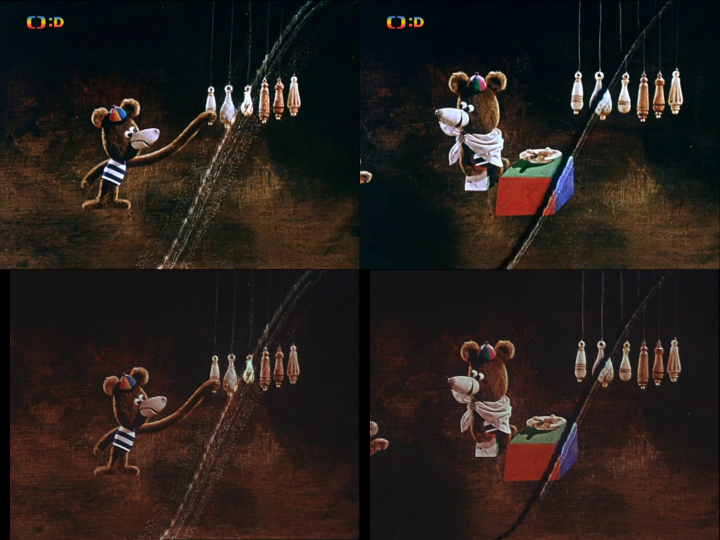
Later, when Vašík jumps down from his little pedestal to converse with Big-as-the-Duke at 9:30 in the ČT version, the Czech DVD is missing five frames of Vašík wagging his finger at Big (by some miracle, the corresponding audio splice manages not to cut out his actual dialogue, but it does cut out the brief pause in his speaking):
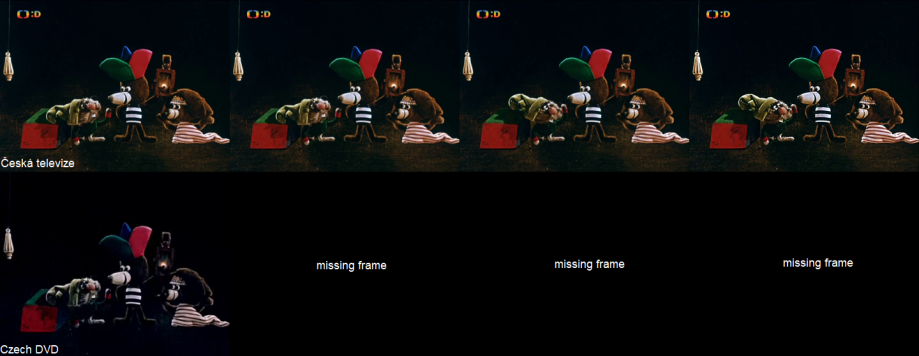
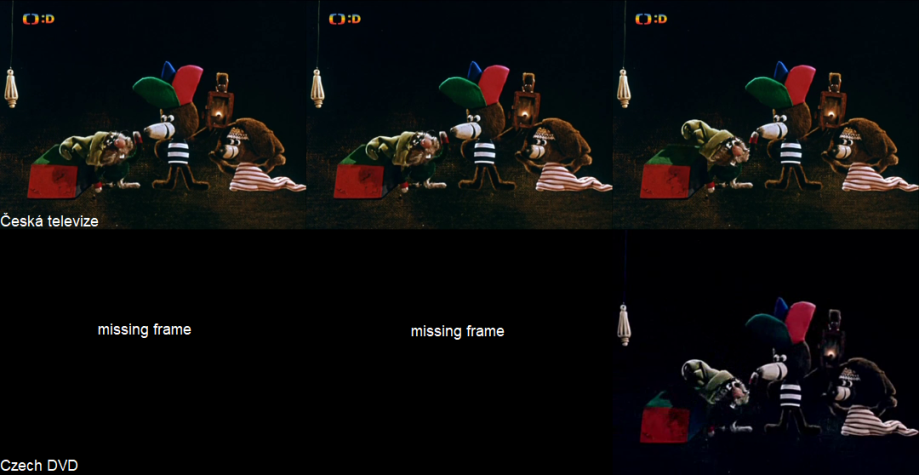
Then, during the “Beaver History” film, in both the NC and ČT versions there’s a frame after the hunter’s beaver-skin thought disappears in which the camera exposure is much brighter for some reason (10:46 in the ČT version). This does not appear in the Czech DVD version.
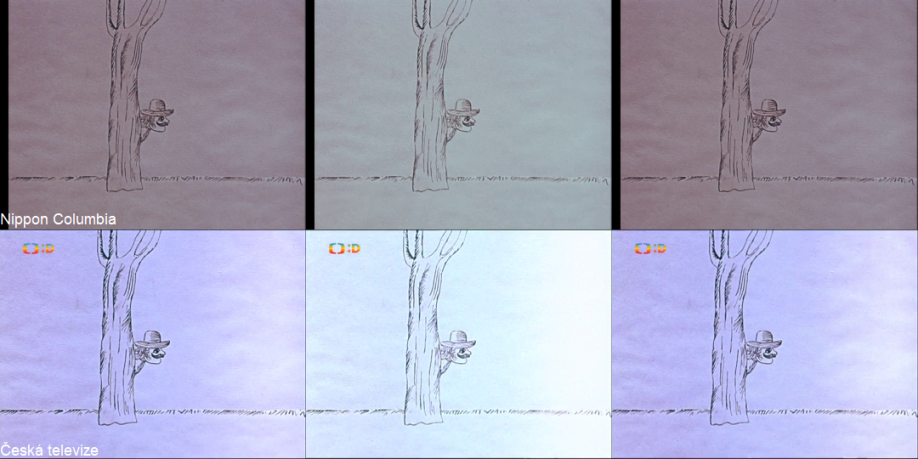
And, as in Panther, the last scene digitally fades out earlier in the Czech DVD version, and the “The End” card also has a digital fade-in and fade-out, looking slower and more smooth than the original fades in the NC and ČT versions. And again, in the NC version, the end card fades out noticeably earlier than in the ČT version (ČT on left, NC sped up to 25 fps in middle, and Czech DVD on right; soundtrack is from the ČT version:
Hello Kohlrabi / Nazdar kedlubny (1973)
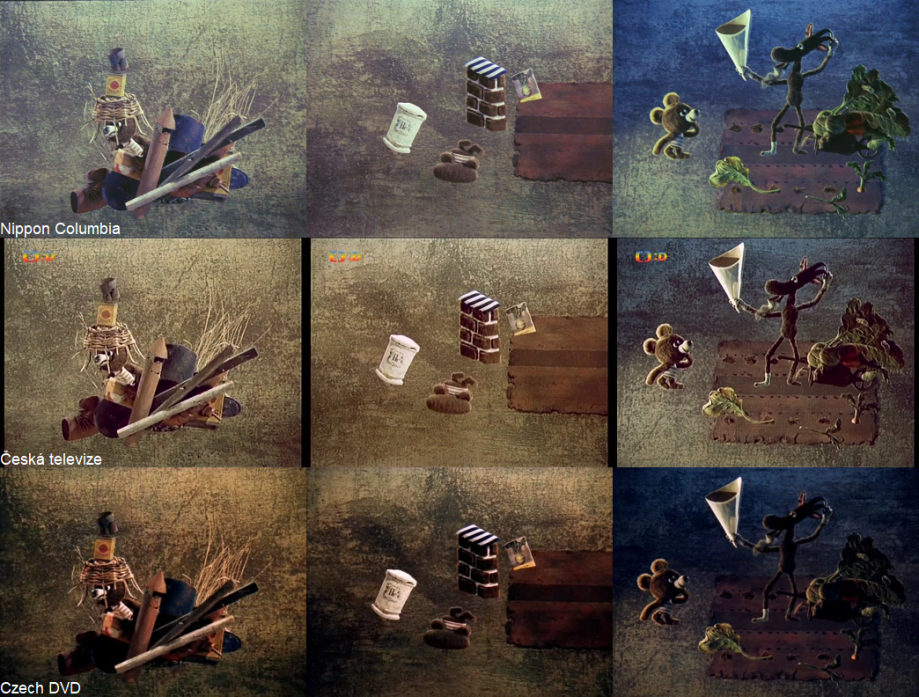
By far the most dramatically-improved film in the Nippon Columbia DVDs compared to any of the Czech versions available—and the one that I immediately knew I had to obtain from those releases—is this entry. Until seeing the compressed YouTube upload of the NC version, I had assumed that the murky, dying, wildfire-ravaged wasteland color scheme of the horribly faded Czech DVD and Česká televize versions was simply how this film was supposed to look. But once Marin showed me that upload, even if (as presented on the DVD and uploaded to YouTube) the NC transfer still looked rather dark for our tastes, the presence of actual colors on even the most minor props was a revelation, and certainly a thousand times better than the Czech copies—and once I obtained this version and brightened it up using a photo posted by Ivan Vít as a guide, it was simply gorgeous. I am very happy to say that I have made this remastered version available for viewing on YouTube for almost a year now—and now, you can download the uncompressed video file too!
Onto the film’s titles: these are by far the most obviously screwed-up in the second series. Owing to the various changes that were happening at Čiklovka at this time, like the departure of Kristina Tichá and the studio’s incorporation into the Jiří Trnka Studio, almost all of the credits in the final version of the film had to be completely reshot—and at this point, there was no attempt on the outside studio’s part to make the new footage even remotely match up with what little of the original credits (which, based on Jan Klos has said, were likely shot before the film actually began production) remained. Not only is the camera exposure much, much brighter in the reshot credits, but the card even flips in the complete opposite direction from how it flipped in the original credits. It’s especially egregious in the transition between the writing credits and the animation-camera-editing credits; the former, preserved from the originally-shot titles, start to spin out, and all of a sudden the backside gets brighter and engages reverse gear as the film cuts to the reshot version of the latter spinning in! (Of course, it goes without saying that the background in the reshot titles is different, too.)
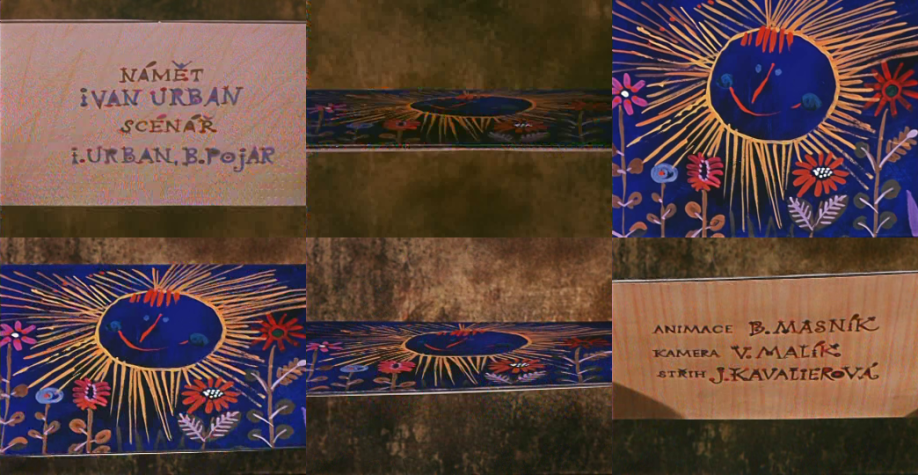
From this point on, Čiklovka’s films in general would separate the producers and the assistants out into separate sets of credits, in contrast to how the previous second-series Bears entries credited them on the same screen. Of course, they still haven’t even bothered to fix technical assistant I. Vít’s miscredit here:
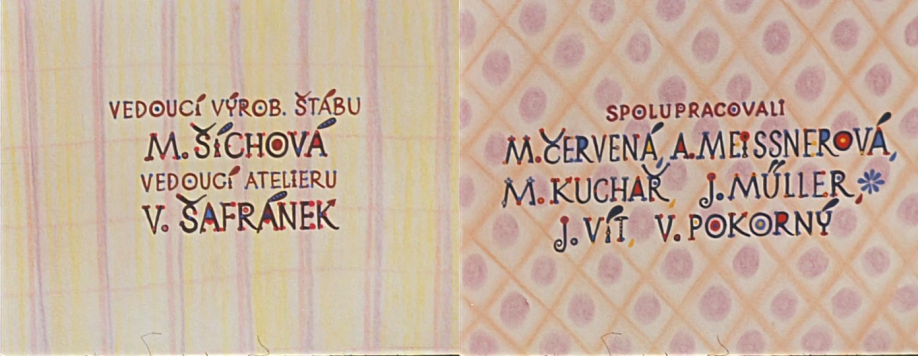
The voice and music credits are preserved from the originally-shot credits—the titles simply cut directly from the reshot assistance credits spinning out to the original voice/music credits flipping towards us, in the opposite direction of course—as are Štěpánek’s and Pojar’s credits. Of course, they have the same background behind them as the title card and writing credits which were also preserved from how they were originally shot—but for some reason their backside is completely different from that of the rest of the credits!
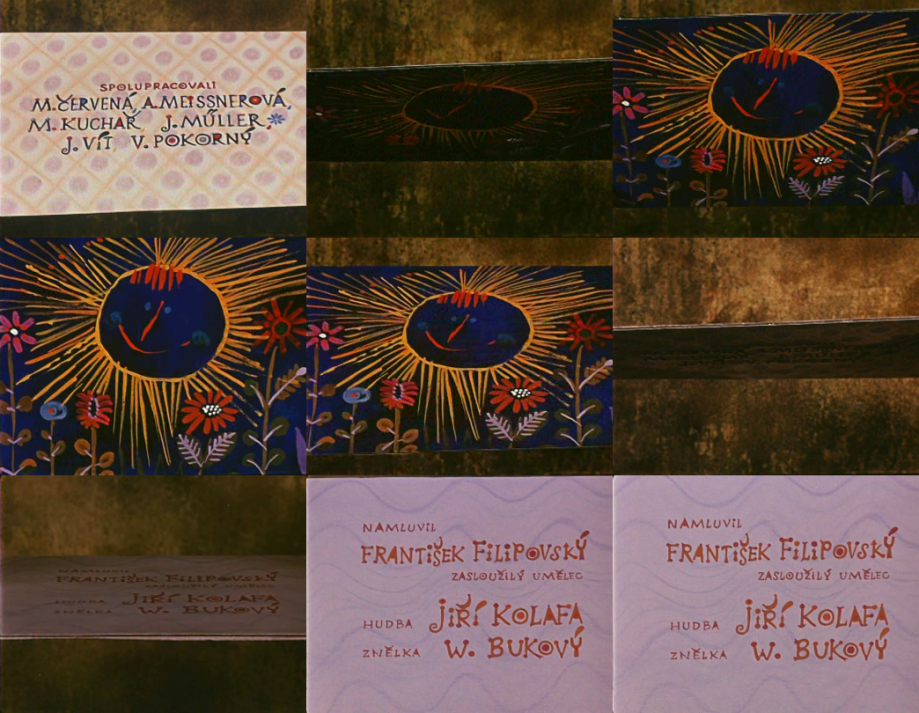

And we get another slapdash cut from just a few frames of the artist-director credits spinning out (again, with their completely different backside!) to the revised copyright card, now crediting the Jiří Trnka Studio, spinning into view in the opposite direction—note how the camera exposure gets darker towards the end of the spin…
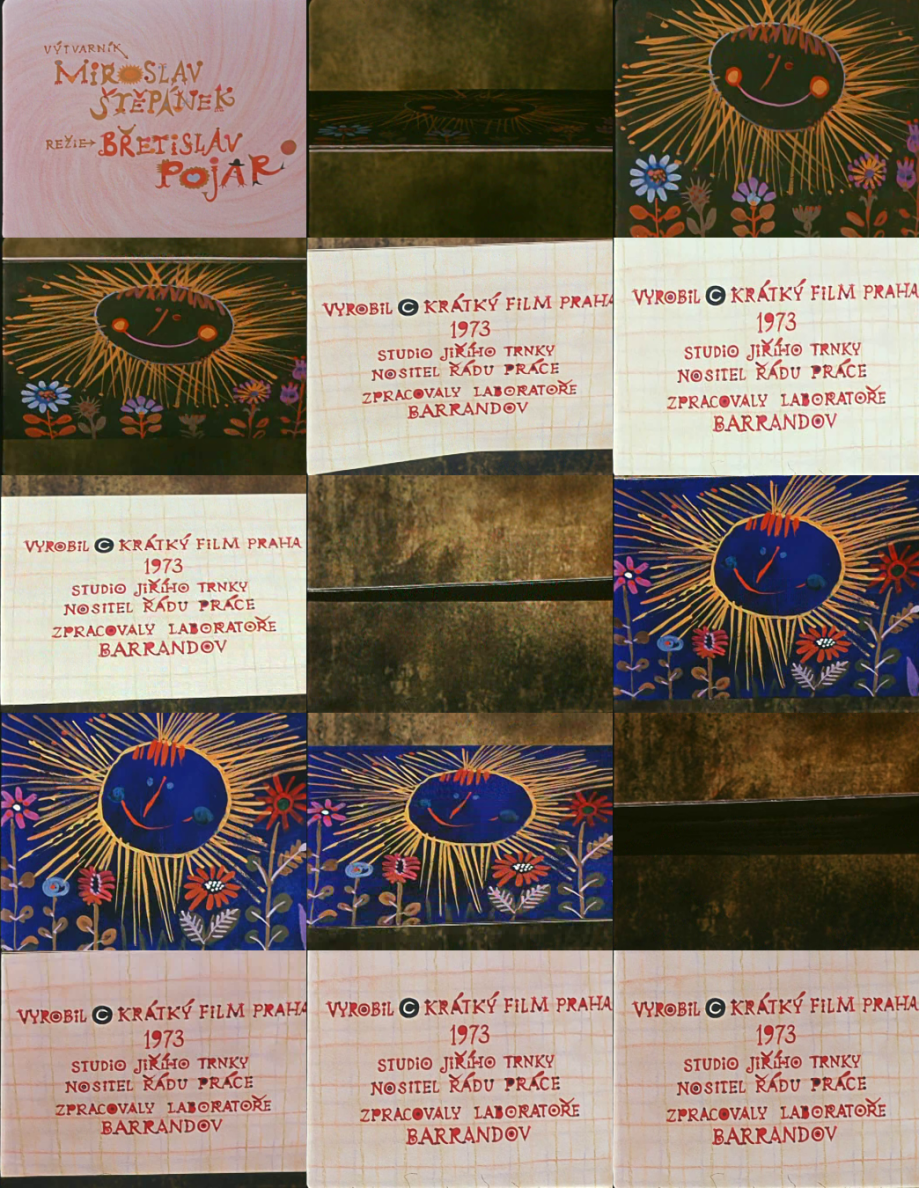
…and then gets much brighter as the card spins out (note how, in the frame right before it begins spinning, it jolts slightly to the right), with a cut to the original, darker footage of the card folding up once it stops:
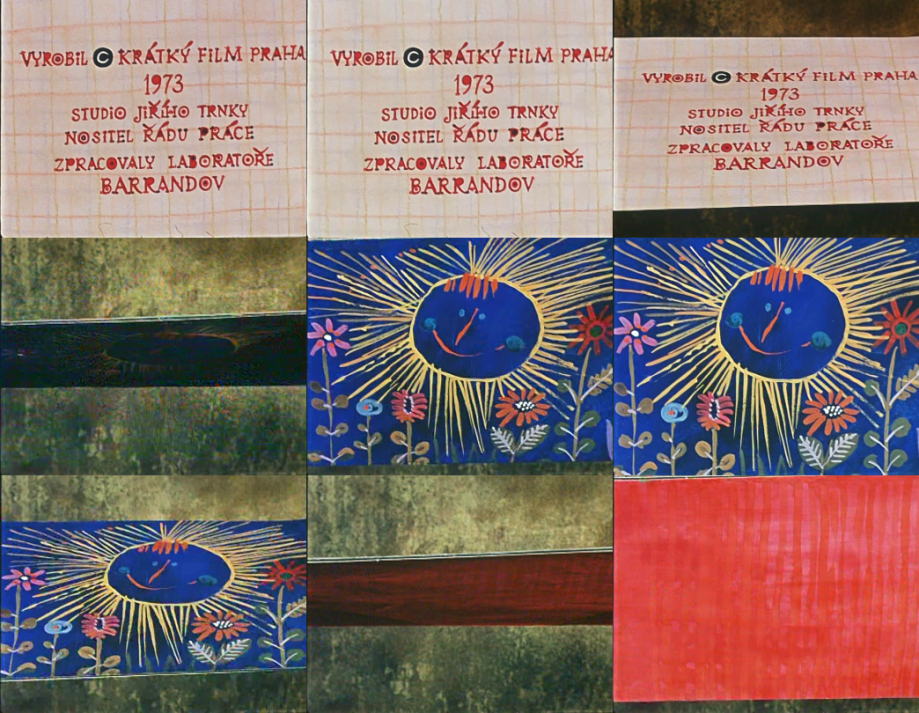
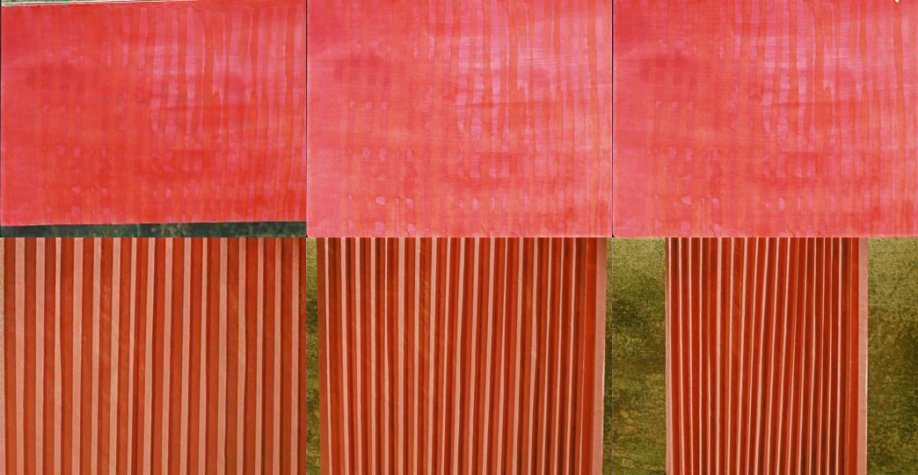
And to top it all off, at this point they’re no longer even trying to properly transition between the titles and the opening scene. The rabbits tear the card open to reveal a blank screen, from which we simply fade in on the opening shot:
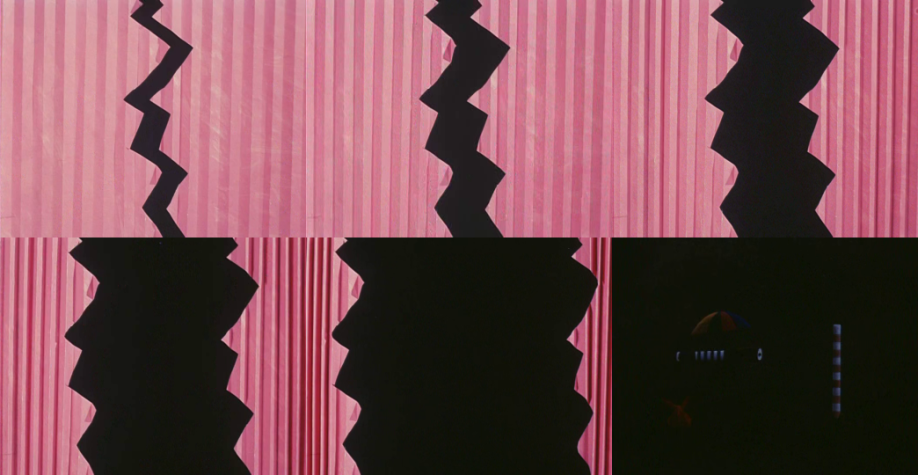
As for the credit deletion in the Czech DVD version, the first splice takes place right as the title card starts to spin out, skipping all the way to the very last spin cycle before the card folds up:
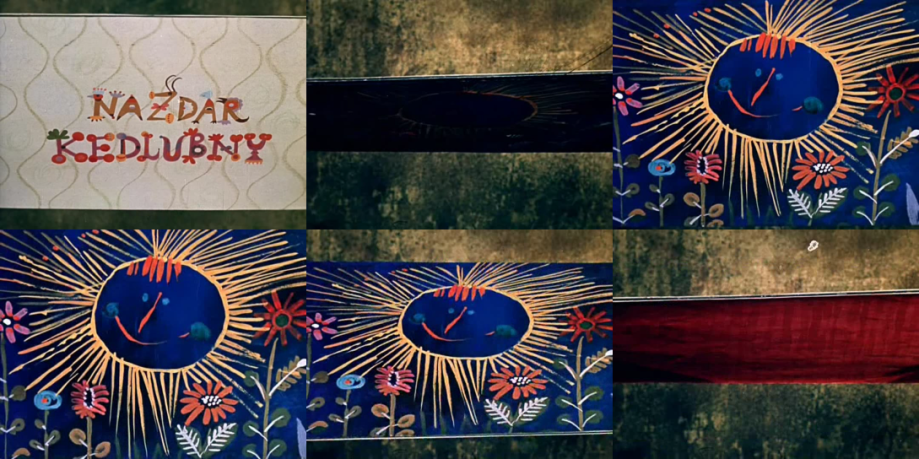
And as in Vašík, the second huge splice does not delete the actual tearing of the card—but it does delete over a whole second of the opening scene, not only the fade-in but also Big jumping up in his telescope form!
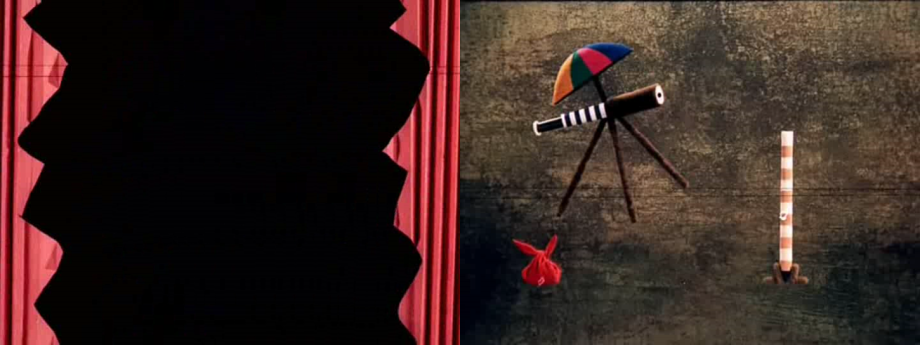
Onto the actual film: to begin with, the Česká televize version—or at least, the copy of it that is available online—suffers from a digital glitch that deletes one of Little’s two mocking, head-prodding “yeah”s in response to Big’s suggestion that this dump could be fertile soil, corresponding to 1:38 in my revision of the Nippon Columbia version. Specifically, compared to even the Czech DVD version, 13 frames of Little prodding his head up are missing in the ČT version.

Little glitching his way through a single “yeah” in the ČT version…
Then, after Big mocks Little for thinking that the vase is scratching itself and is about to transform into a mallet (3:25 in the revised NC version), there’s a small splice in the Czech DVD version that removes a frame of Big lowering his arm as he prepares to turn into a mallet:
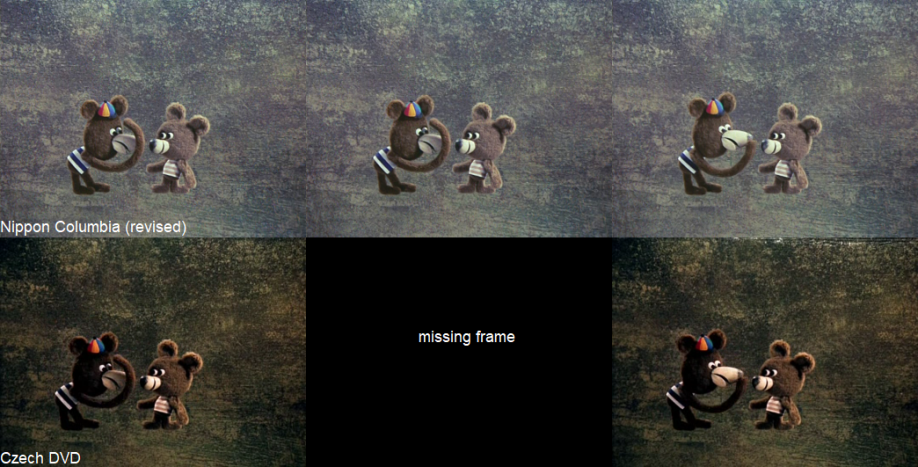
Afterwards, as Jára attempts to smack his briefcase open to begin his magic show (5:09 in the revised NC version), the Czech DVD version has a splice that deletes two frames of the briefcase twirling in the air:
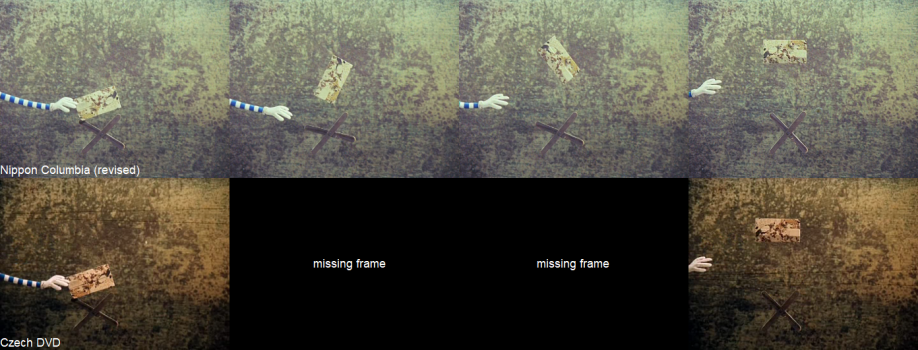
Then, in the cut between Big asking Little what’s wrong and Little being disappointed (6:21 in the revised NC version), there is yet another splice in the Czech DVD version that deletes the last two frames of Big standing there:

Much later, the cut between the two shots of the watering can-Bears ascending back into the sky (12:29 in the revised NC version) has some serious film damage in the NC version, present neither in the ČT nor in the Czech DVD versions:
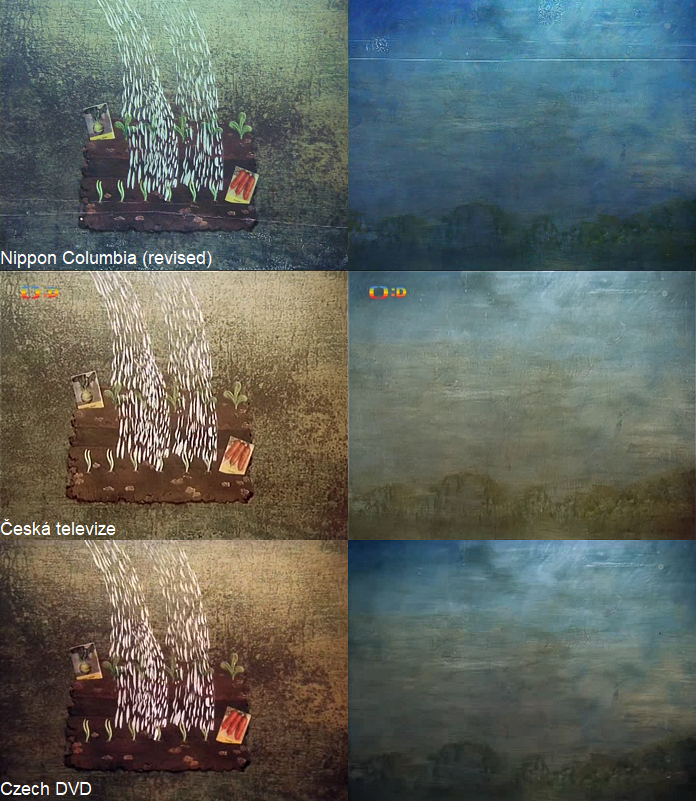
A short time afterwards, the shot of Big looking with surprise at Little trying to defeat the butterflies has more damage in the NC version (13:16 in the revised version):
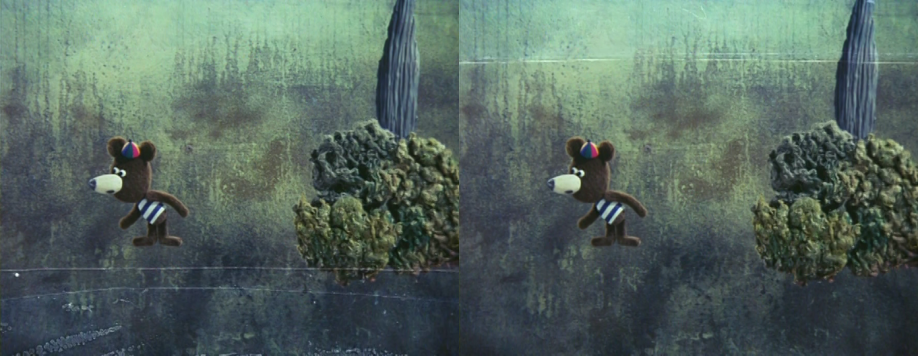
Later, during the final chase, the scene of the Bears getting hit by Jára’s thrown vegetables for the first time and Big firing Little as an umbrella is ruined in the Czech DVD version. Some frames of the Bears actually getting squished against the kohlrabi are missing, and to keep time with the soundtrack, the entire rest of the scene is slowed down, creating a distinct ghosting effect; see the comparison between the revised NC (sped up to 25 fps) and Czech DVD versions (audio from the NC version):
Then, the brief shot of Jára trying to throw vegetables for the last time is similarly ruined in the Czech DVD. A few frames of Jára actually picking the kohlrabi up are missing, and the rest of the shot is slowed down and ghosted in a vain attempt to compensate; see this comparison between the revised NC (sped up to 25 fps) and Czech DVD versions:
And, once more, a digital fade-out is added to the final scene in the Czech DVD version, and the “The End” card’s fades in and out are slower and digital compared to the NC and ČT versions too. And once again, the NC version’s fade-out is earlier than the ČT version’s (ČT on left, revised NC sped up to 25 fps in middle, and Czech DVD on right; soundtrack is from the ČT version):
So, in the end, what exactly is the takeaway from this post? Well, for one thing, I hope I’ve managed to succinctly illustrate how utterly botched and screwed-up the Czech DVD versions of the Bears series are, and how disgraceful it is that these frankly desecrated, ruined versions were the only way most fans could view the Bears for some 15 or so years. In that regard, I highly encourage more people to seek out and watch the Nippon Columbia versions of the second Bears series, since they remain the best releases of those shorts to this day and the closest to how they must have looked in theaters. Of course, it’s absurd that Krátký Film did not even bother to make the Nippon Columbia versions available in the Bears’ own home country, in spite of the Japanese and Czech DVDs being released practically around the same time.
For that matter, assuming that the Nippon Columbia versions were transferred from the original negatives, the fact that they have some instances of film damage that aren’t present on the crummy Czech DVD versions is a very troubling indication of the fine treatment Krátký Film has given its own heritage. We can only hope that the negatives have not suffered even more damage and deterioration in the roughly 20 years that have passed since these old DVDs were released, especially now that the company in its current decrepit, dormant state is refusing to begin turning them over to the Czech National Film Archive as they are legally obligated to do. (Officially, Hello Kohlrabi will not belong to the NFA until 2024…)
It would be a mistake to assume, by the way, that Krátký Film Praha’s criminal neglect of its own film heritage is simply an inevitable result of its privatization: the studio’s malpractice against its legacy is a long-standing pattern that goes back to its Communist-era heyday. Jan Klos once recalled to Marin the ridiculous difficulties that animator Stanislav Látal faced in the late 1980s, when he was directing a new stop-motion series based on The Good Soldier Švejk that would incorporate footage from Jiří Trnka’s previous three adaptations—as the negatives of the original films proved to be unlocatable or unusable, he ended up having to use shabbier prints of Trnka’s films, and from there had to recreate their deteriorated look in the newly-animated sequences in order that the old and new sections could blend seamlessly with each other:
A note about the real “care” for the legacy of the J. Trnka studio, which I witnessed with my own eyes: When some West German company ordered more episodes of the puppet Švejk (Trnka once filmed three episodes), the director S. Látal looked for the negatives of those Trnka episodes and found out that the Krátký Film archive, located somewhere in northern Bohemia, does not have them, or that they are in such a state that they cannot be used. Then the production studio looked everywhere possible for any projected copies of those Trnka episodes and – I don’t know who – paid for the production of new negatives from those positives – poor image quality. The new episodes of Švejk [there were 9 in total] were filmed in simulated poor quality, like the episodes they had taken from the positives. It was quite a strenuous job for the cameraman to imitate the blurriness, scratches and so on. I followed the story in close proximity while occupied on a studio commission for some Austrian-Czech company. I have no other experience, but I experienced the “scorn” of the commanders of Kr. Film Praha for such “rubbish” as e.g. a puppet film every day for the whole 30 years [of my stop-motion career].
One thought on “Appendix: A Comparison Between the Czech DVD, Česká televize, and Nippon Columbia Versions of “Who Threw That, Gentlemen?” (1970-73), and the Devolution of the Series’ Opening Titles”